土木工程专业英语译文
完整版土木工程专业英语课文原文及对照翻译
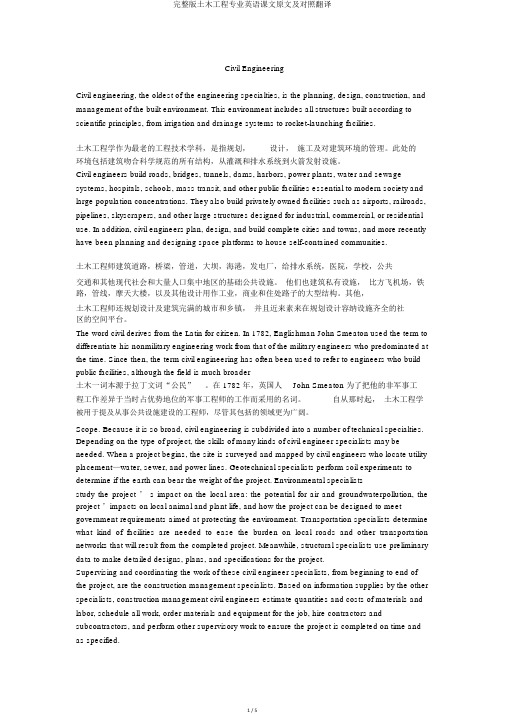
Civil EngineeringCivil engineering, the oldest of the engineering specialties, is the planning, design, construction, and management of the built environment. This environment includes all structures built according to scientific principles, from irrigation and drainage systems to rocket-launching facilities.土木工程学作为最老的工程技术学科,是指规划,设计,施工及对建筑环境的管理。
此处的环境包括建筑吻合科学规范的所有结构,从灌溉和排水系统到火箭发射设施。
Civil engineers build roads, bridges, tunnels, dams, harbors, power plants, water and sewage systems, hospitals, schools, mass transit, and other public facilities essential to modern society and large population concentrations. They also build privately owned facilities such as airports, railroads, pipelines, skyscrapers, and other large structures designed for industrial, commercial, or residential use. In addition, civil engineers plan, design, and build complete cities and towns, and more recently have been planning and designing space platforms to house self-contained communities.土木工程师建筑道路,桥梁,管道,大坝,海港,发电厂,给排水系统,医院,学校,公共交通和其他现代社会和大量人口集中地区的基础公共设施。
土木工程专业英语(苏小卒版)翻译

土木工程英语
Smeaton, the builder of famous Eddystone lighthouse near Plymouth, England, is said to have begun calling himself a “civil engineer” to distinguish himself from the military engineers of his time. However, the profession is as old as civilization.
希腊建筑师通常是建筑工程杰作的设计师同时也是建造师。 他既是一个建 筑师也是工程师。工匠、石匠和雕塑家在他的监督下工作。在希腊古典时期所
2
土木工程英语
有重要建筑物是由石灰石或大理石建造的;以帕台农神庙为例,由大理石建成 的。
UNIT 3 The principal construction materials of earlier times were wood and masonry-brick, stone, or tile, and similar materials. The courses or layers(砖层) were bound together with mortar or bitumen, a tarlike substance, or some other binding agent. The Greeks and Romans sometimes used iron rods or clamps to strengthen their building. The columns of the Parthenon in Athen(s 雅典的帕台农 神庙), for example, have holes drilled(钻孔) in them for iron bars that have now rusted away(锈蚀殆尽). The Romans also used a natural cement called pozzolana, made from volcanic ash, that became as hard as stone under water.
土木工程专业英语翻译
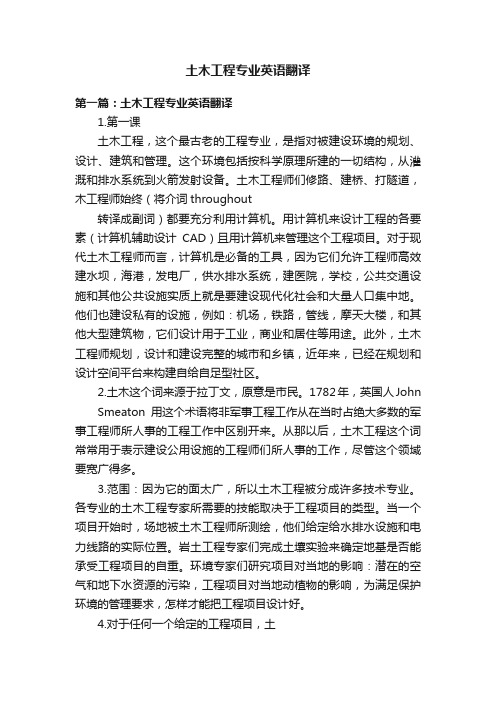
土木工程专业英语翻译第一篇:土木工程专业英语翻译1.第一课土木工程,这个最古老的工程专业,是指对被建设环境的规划、设计、建筑和管理。
这个环境包括按科学原理所建的一切结构,从灌溉和排水系统到火箭发射设备。
土木工程师们修路、建桥、打隧道,木工程师始终(将介词throughout转译成副词)都要充分利用计算机。
用计算机来设计工程的各要素(计算机辅助设计CAD)且用计算机来管理这个工程项目。
对于现代土木工程师而言,计算机是必备的工具,因为它们允许工程师高效建水坝,海港,发电厂,供水排水系统,建医院,学校,公共交通设施和其他公共设施实质上就是要建设现代化社会和大量人口集中地。
他们也建设私有的设施,例如:机场,铁路,管线,摩天大楼,和其他大型建筑物,它们设计用于工业,商业和居住等用途。
此外,土木工程师规划,设计和建设完整的城市和乡镇,近年来,已经在规划和设计空间平台来构建自给自足型社区。
2.土木这个词来源于拉丁文,原意是市民。
1782年,英国人JohnSmeaton用这个术语将非军事工程工作从在当时占绝大多数的军事工程师所人事的工程工作中区别开来。
从那以后,土木工程这个词常常用于表示建设公用设施的工程师们所人事的工作,尽管这个领域要宽广得多。
3.范围:因为它的面太广,所以土木工程被分成许多技术专业。
各专业的土木工程专家所需要的技能取决于工程项目的类型。
当一个项目开始时,场地被土木工程师所测绘,他们给定给水排水设施和电力线路的实际位置。
岩土工程专家们完成土壤实验来确定地基是否能承受工程项目的自重。
环境专家们研究项目对当地的影响:潜在的空气和地下水资源的污染,工程项目对当地动植物的影响,为满足保护环境的管理要求,怎样才能把工程项目设计好。
4.对于任何一个给定的工程项目,土地处理大量的用来制定工程最佳施工方法的数据。
5.结构工程.在这个专业中,土木工程师计划和设计各种各样的结构,包括桥,水坝,发电厂,设备的支柱,海岸工程的特殊结构,美国空间项目,发射塔,巨大的天文射电望远镜,和许多种其它的工程项目。
土木工程专业英语(带翻译)

State-of-the-art report of bridge health monitoring AbstractThe damage diagnosis and healthmonitoring of bridge structures are active areas of research in recent years. Comparing with the aerospace engineering and mechanical engineering, civil engineering has the specialities of its own in practice. For example, because bridges, as well as most civil engineering structures, are large in size, and have quite lownatural frequencies and vibration levels, at low amplitudes, the dynamic responses of bridge structure are substantially affected by the nonstructural components, unforeseen environmental conditions, and changes in these components can easily to be confused with structural damage.All these give the damage assessment of complex structures such as bridges a still challenging task for bridge engineers. This paper firstly presents the definition of structural healthmonitoring system and its components. Then, the focus of the discussion is placed on the following sections:①the laboratory and field testing research on the damage assessment;②analytical developments of damage detectionmethods, including (a) signature analysis and pattern recognition approaches, (b) model updating and system identification approaches, (c) neural networks approaches; and③sensors and their optimum placements. The predominance and shortcomings of each method are compared and analyzed. Recent examples of implementation of structural health monitoring and damage identification are summarized in this paper. The key problem of bridge healthmonitoring is damage automatic detection and diagnosis, and it is the most difficult problem. Lastly, research and development needs are addressed.1 IntroductionDue to a wide variety of unforeseen conditions and circumstance, it will never be possible or practical to design and build a structure that has a zero percent probability of failure. Structural aging, environmental conditions, and reuse are examples of circumstances that could affect the reliability and the life of a structure. There are needs of periodic inspections to detect deterioration resulting from normal operation and environmental attack or inspections following extreme events, such as strong-motion earthquakes or hurricanes. To quantify these system performance measures requires some means to monitor and evaluate the integrity of civil structureswhile in service. Since the Aloha Boeing 737 accident that occurred on April28, 1988, such interest has fostered research in the areas of structural health monitoring and non-destructive damage detection in recent years.According to Housner, et al. (1997), structural healthmonitoring is defined as“the use ofin-situ,non-destructive sensing and analysis of structural characteristics, including the structural response, for detecting changes that may indicate damage or degradation”[1]. This definition also identifies the weakness. While researchers have attempted the integration of NDEwith healthmonitoring, the focus has been on data collection, not evaluation. What is needed is an efficient method to collect data from a structure in-service and process the data to evaluate key performance measures, such as serviceability, reliability, and durability. So, the definition byHousner, et al.(1997)should be modified and the structural health monitoring may be defined as“the use ofin-situ,nondestructive sensing and analysis of structural characteristics, including the structural response, for the purpose of identifying if damage has occurred, determining the location of damage, estimatingthe severityof damage and evaluatingthe consequences of damage on the structures”(Fig.1). In general, a structural health monitoring system has the potential to provide both damage detection and condition assessment of a structure.Assessing the structural conditionwithout removingthe individual structural components is known as nondestructive evaluation (NDE) or nondestructive inspection. NDE techniques include those involving acoustics, dye penetrating,eddy current, emission spectroscopy, fiber-optic sensors, fiber-scope, hardness testing, isotope, leak testing, optics, magnetic particles, magnetic perturbation, X-ray, noise measurements, pattern recognition, pulse-echo, ra-diography, and visual inspection, etc. Mostof these techniques have been used successfullyto detect location of certain elements, cracks orweld defects, corrosion/erosion, and so on. The FederalHighwayAdministration(FHWA, USA)was sponsoring a large program of research and development in new technologies for the nondestructive evaluation of highway bridges. One of the two main objectives of the program is to develop newtools and techniques to solve specific problems. The other is to develop technologies for the quantitative assessment of the condition of bridges in support of bridge management and to investigate howbest to incorporate quantitative condition information into bridge management systems. They hoped to develop technologies to quickly, efficiently, and quantitatively measure global bridge parameters, such as flexibility and load-carrying capacity. Obviously, a combination of several NDEtechniques may be used to help assess the condition of the system. They are very important to obtain the data-base for the bridge evaluation.But it is beyond the scope of this review report to get into details of local NDE.Health monitoring techniques may be classified as global and local. Global attempts to simultaneously assess the condition of the whole structure whereas local methods focus NDE tools on specific structural components. Clearly, two approaches are complementaryto eachother. All such available informationmaybe combined and analyzed by experts to assess the damage or safety state of the structure.Structural health monitoring research can be categorized into the following four levels: (I) detecting the existence of damage, (II) findingthe location of damage, (III) estimatingthe extentof damage, and (IV) predictingthe remaining fatigue life. The performance of tasks of Level (III) requires refined structural models and analyses, local physical examination, and/or traditional NDE techniques. To performtasks ofLevel (IV) requires material constitutive information on a local level, materials aging studies, damage mechanics, and high-performance computing. With improved instrumentation and understanding of dynamics of complex structures, health monitoring and damage assessment of civil engineering structures has become more practical in systematic inspection and evaluation of these structures during the past two decades.Most structural health monitoringmethods under current investigation focus on using dynamic responses to detect and locate damage because they are global methods that can provide rapid inspection of large structural systems.These dynamics-based methods can be divided into fourgroups:①spatial-domain methods,②modal-domain methods,③time-domain methods, and④frequency- domain methods. Spatial-domain methods use changes of mass, damping, and stiffness matrices to detect and locate damage. Modal-domain methods use changes of natural frequencies, modal damping ratios, andmode shapesto detect damage. In the frequency domain method, modal quantities such as natural frequencies, damping ratio, and model shapes are identified.The reverse dynamic systemof spectral analysis and the generalized frequency response function estimated fromthe nonlinear auto-regressive moving average (NARMA) model were applied in nonlinear system identification. In time domainmethod, systemparameterswere determined fromthe observational data sampled in time. It is necessaryto identifythe time variation of systemdynamic characteristics fromtime domain approach if the properties of structural systemchangewith time under the external loading condition. Moreover, one can use model-independent methods or model-referenced methods to perform damage detection using dynamic responses presented in any of the four domains. Literature shows that model independent methods can detect the existence of damage without much computational efforts, butthey are not accurate in locating damage. On the otherhand, model-referencedmethods are generally more accurate in locating damage and require fewer sensors than model-independent techniques, but they require appropriate structural models and significant computational efforts. Although time-domain methods use original time-domain datameasured using conventional vibrationmeasurement equipment, theyrequire certain structural information and massive computation and are case sensitive. Furthermore, frequency- and modal-domain methods use transformed data,which contain errors and noise due totransformation.Moreover, themodeling and updatingofmass and stiffnessmatrices in spatial-domain methods are problematic and difficult to be accurate. There are strong developmenttrends that two or three methods are combined together to detect and assess structural damages.For example, several researchers combined data of static and modal tests to assess damages. The combination could remove the weakness of each method and check each other. It suits the complexity of damage detection.Structural health monitoring is also an active area of research in aerospace engineering, but there are significant differences among the aerospace engineering, mechanical engineering, and civil engineering in practice. For example,because bridges, as well as most civil engineering structures, are large in size, and have quite lownatural frequencies and vibration levels, at lowamplitudes, the dynamic responses of bridge structure are substantially affected by the non-structural components, and changes in these components can easily to be confused with structural damage. Moreover,the level of modeling uncertainties in reinforced concrete bridges can be much greater than the single beam or a space truss. All these give the damage assessment of complex structures such as bridges a still challenging task for bridge engineers. Recent examples of research and implementation of structural health monitoring and damage assessment are summarized in the following sections.2 Laboratory and field testing researchIn general, there are two kinds of bridge testing methods, static testing and dynamic testing. The dynamic testing includes ambient vibration testing and forcedvibration testing. In ambient vibration testing, the input excitation is not under the control. The loading could be either micro-tremors, wind, waves, vehicle or pedestrian traffic or any other service loading. The increasing popularity of this method is probably due to the convenience of measuring the vibrationresponse while the bridge is under in-service and also due to the increasing availability of robust data acquisition and storage systems. Since the input is unknown, certain assumptions have to be made. Forced vibration testing involves application of input excitation of known force level at known frequencies. The excitation manners include electro-hydraulic vibrators, force hammers, vehicle impact, etc. The static testing in the laboratory may be conducted by actuators, and by standard vehicles in the field-testing.we can distinguish that①the models in the laboratory are mainly beams, columns, truss and/or frame structures, and the location and severity of damage in the models are determined in advance;②the testing has demonstrated lots of performances of damage structures;③the field-testing and damage assessmentof real bridges are more complicated than the models in the laboratory;④the correlation between the damage indicator and damage type,location, and extentwill still be improved.3Analytical developmentThe bridge damage diagnosis and health monitoring are both concerned with two fundamental criteria of the bridges, namely, the physical condition and the structural function. In terms of mechanics or dynamics, these fundamental criteria can be treated as mathematical models, such as response models, modal models and physical models.Instead of taking measurements directly to assess bridge condition, the bridge damage diagnosis and monitoring systemevaluate these conditions indirectly by using mathematical models. The damage diagnosis and health monitoring are active areas of research in recentyears. For example, numerous papers on these topics appear in the proceedings of Inter-national Modal Analysis Conferences (IMAC) each year, in the proceedings of International Workshop on Structural HealthMonitoring (once of two year, at Standford University), in the proceedings of European Conference on Smart materials and Structures and European Conference on Structural Damage AssessmentUsing Advanced Signal Processing Procedures, in the proceedings ofWorld Conferences of Earthquake Engineering, and in the proceedings of International Workshop on Structural Control, etc.. There are several review papers to be referenced, for examples,Housner, et al. (1997)provided an extensive summary ofthe state of the art in control and health monitoring of civil engineering structures[1].Salawu (1997)discussed and reviewed the use of natural frequency as a diagnostic parameter in structural assessment procedures using vibration monitoring.Doebling, Farrar, et al. (1998)presented a through review of the damage detection methods by examining changes in dynamic properties.Zou, TongandSteven (2000)summarized the methods of vibration-based damage and health monitoring for composite structures, especially in delamination modeling techniques and delamination detection.4Sensors and optimum placementOne of the problems facing structural health monitoring is that very little is known about the actual stress and strains in a structure under external excitations. For example, the standard earthquake recordings are made ofmotions of the floors of the structure and no recordings are made of the actual stresses and strains in structural members. There is a need for special sensors to determine the actual performance of structural members. Structural health monitoring requires integrated sensor functionality to measure changes in external environmental conditions, signal processing functionality to acquire, process, and combine multi-sensor and multi-measured information. Individual sensors and instrumented sensor systems are then required to provide such multiplexed information.FuandMoosa (2000)proposed probabilistic advancing cross-diagnosis method to diagnosis-decision making for structural health monitoring. It was experimented in the laboratory respectively using a coherent laser radar system and a CCD high-resolution camera. Results showed that this method was promising for field application. Another new idea is thatneural networktechniques are used to place sensors. For example,WordenandBurrows (2001)used the neural network and methods of combinatorial optimization to locate and classify faults.The static and dynamic data are collected from all kinds of sensorswhich are installed on the measured structures.And these datawill be processed and usable informationwill be extracted. So the sensitivity, accuracy, and locations,etc. of sensors are very important for the damage detections. The more information are obtained, the damage identification will be conducted more easily, but the price should be considered. That’s why the sensors are determined in an optimal ornearoptimal distribution. In aword, the theory and validation ofoptimumsensor locationswill still being developed.5 Examples of health monitoring implementationIn order for the technology to advance sufficiently to become an operational system for the maintenance and safety of civil structures, it is of paramount importance that new analytical developments are ultimately verified with appropriate data obtained frommonitoring systems, which have been implemented on civil structures, such as bridges.Mufti (2001)summarized the applications of SHM of Canadian bridge engineering, including fibre-reinforced polymers sensors, remote monitoring, intelligent processing, practical applications in bridge engineering, and technology utilization. Further study and applications are still being conducted now.FujinoandAbe(2001)introduced the research and development of SHMsystems at the Bridge and Structural Lab of the University of Tokyo. They also presented the ambient vibration based approaches forLaser DopplerVibrometer (LDV) and the applications in the long-span suspension bridges.The extraction of the measured data is very hard work because it is hard to separate changes in vibration signature duo to damage form changes, normal usage, changes in boundary conditions, or the release of the connection joints.Newbridges offer opportunities for developing complete structural health monitoring systems for bridge inspection and co ndition evaluation from“cradle to grave”of the bridges. Existing bridges provide challenges for applying state-of-the-art in structural health monitoring technologies to determine the current conditions of the structural element,connections and systems, to formulate model for estimating the rate of degradation, and to predict the existing and the future capacities of the structural components and systems. Advanced health monitoring systems may lead to better understanding of structural behavior and significant improvements of design, as well as the reduction of the structural inspection requirements. Great benefits due to the introduction of SHM are being accepted by owners, managers, bridge engineers, etc..6 Research and development needsMost damage detection theories and practices are formulated based on the following assumption: that failure or deterioration would primarily affect the stiffness and therefore affect the modal characteristics of the dynamic response of the structure. This is seldom true in practice, because①Traditional modal parameters (natural frequency, damping ratio and mode shapes, etc.) are not sensitive enough to identifyand locate damage. The estimation methods usually assume that structures are linear and proportional damping systems.②Most currently used damage indices depend on the severity of the damage, which is impractical in the field. Most civil engineering structures, such as highway bridges, have redundancy in design and large in size with low natural frequencies. Any damage index should consider these factors.③Scaledmodelingtechniques are used in currentbridge damage detection. Asingle beam/girder models cannot simulate the true behavior of a real bridge. Similitude laws for dynamic simulation and testing should be considered.④Manymethods usually use the undamaged structural modal parameters as the baseline comparedwith the damaged information. This will result in the need of a large data storage capacity for complex structures. But in practice,there are majority of existing structures for which baseline modal responses are not available. Only one developed method(StubbsandKim (1996)), which tried to quantify damagewithout using a baseline, may be a solution to this difficulty. There is a lot of researchwork to do in this direction.⑤Seldommethods have the ability to distinguish the type of damages on bridge structures. To establish the direct relationship between the various damage patterns and the changes of vibrational signatures is not a simple work.Health monitoring requires clearly defined performance criteria, a set of corresponding condition indicators and global and local damage and deterioration indices, which should help diagnose reasons for changes in condition indicators. It is implausible to expect that damage can be reliably detected or tracked by using a single damage index. We note that many additional localized damage indiceswhich relate to highly localized properties ofmaterials or the circumstances may indicate a susceptibility of deterioration such as the presence of corrosive environments around reinforcing steel in concrete, should be also integrated into the health monitoring systems.There is now a considerable research and development effort in academia, industry, and management department regarding global healthmonitoring for civil engineering structures. Several commercial structural monitoring systems currently exist, but further development is needed in commercialization of the technology. We must realize that damage detection and health monitoring for bridge structures by means of vibration signature analysis is a very difficult task. Itcontains several necessary steps, including defining indicators on variations of structural physical condition, dynamic testing to extract such indication parameters,defining the type of damages and remaining capacity or life of the structure, relating the parameters to the defined damage/aging. Unfortunately, to date, no one has accomplished the above steps. There is a lot of work to do in future.桥梁健康监测应用与研究现状摘要桥梁损伤诊断与健康监测是近年来国际上的研究热点,在实践方面,土木工程和航空航天工程、机械工程有明显的差别,比如桥梁结构以及其他大多数土木结构,尺寸大、质量重,具有较低的自然频率和振动水平,桥梁结构的动力响应极容易受到不可预见的环境状态、非结构构件等的影响,这些变化往往被误解为结构的损伤,这使得桥梁这类复杂结构的损伤评估具有极大的挑战性.本文首先给出了结构健康监测系统的定义和基本构成,然后集中回顾和分析了如下几个方面的问题:①损伤评估的室内实验和现场测试;②损伤检测方法的发展,包括:(a)动力指纹分析和模式识别方法, (b)模型修正和系统识别方法, (c)神经网络方法;③传感器及其优化布置等,并比较和分析了各自方法的优点和不足.文中还总结了健康监测和损伤识别在桥梁工程中的应用,指出桥梁健康监测的关键问题在于损伤的自动检测和诊断,这也是困难的问题;最后展望了桥梁健康监测系统的研究和发展方向.关键词:健康监测系统;损伤检测;状态评估;模型修正;系统识别;传感器优化布置;神经网络方法;桥梁结构1概述由于不可预见的各种条件和情况下,设计和建造一个结构将永远不可能或无实践操作性,它有一个失败的概率百分之零。
土木工程专业英语翻译
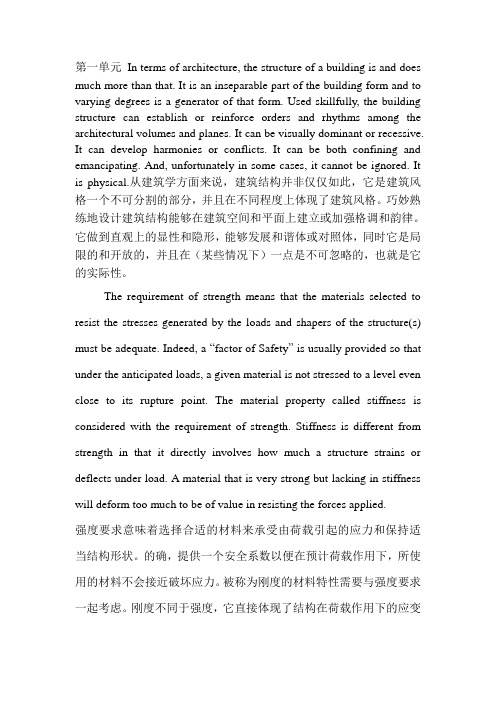
第一单元In terms of architecture, the structure of a building is and does much more than that. It is an inseparable part of the building form and to varying degrees is a generator of that form. Used skillfully, the building structure can establish or reinforce orders and rhythms among the architectural volumes and planes. It can be visually dominant or recessive. It can develop harmonies or conflicts. It can be both confining and emancipating. And, unfortunately in some cases, it cannot be ignored. It is physical.从建筑学方面来说,建筑结构并非仅仅如此,它是建筑风格一个不可分割的部分,并且在不同程度上体现了建筑风格。
巧妙熟练地设计建筑结构能够在建筑空间和平面上建立或加强格调和韵律。
它做到直观上的显性和隐形,能够发展和谐体或对照体,同时它是局限的和开放的,并且在(某些情况下)一点是不可忽略的,也就是它的实际性。
The requirement of strength means that the materials selected to resist the stresses generated by the loads and shapers of the structure(s) must be adequate. Indeed, a “factor of Safety” is usually provided so that under the anticipated loads, a given material is not stressed to a level even close to its rupture point. The material property called stiffness is considered with the requirement of strength. Stiffness is different from strength in that it directly involves how much a structure strains or deflects under load. A material that is very strong but lacking in stiffness will deform too much to be of value in resisting the forces applied.强度要求意味着选择合适的材料来承受由荷载引起的应力和保持适当结构形状。
土木工程专业英语课文翻译考试必备

土木工程专业英语课文_翻译_考试必备土木工程专业英语课文翻译The principal construction materials of earlier times were wood and masonry brick, stone, or tile, and similar materials. The courses or layers were bound together with mortar or bitumen, a tar like substance, or some other binding agent. The Greeks and Romanssometimes used iron rods or claps to strengthen their building. The columns of the Parthenon in Athens, for example, have holes drilled in them for iron bars that have now rusted away. The Romans also used a natural cement called puzzling, made from volcanic ash, that became as hard as stone under water.早期时代的主要施工材料,木材和砌体砖,石,或瓷砖,和类似的材料;这些课程或层密切联系在一起,用砂浆或沥青,焦油一个样物质,或其他一些有约束力的代理人;希腊人和罗马人有时用铁棍或拍手以加强其建设;在雅典的帕台农神庙列,例如,在他们的铁钻的酒吧现在已经生锈了孔;罗马人还使用了天然水泥称为令人费解的,由火山灰制成,变得像石头一样坚硬在水中;Both steel and cement, the two most important construction materials of modern times, were introduced in the nineteenth century. Steel, basically an alloy of iron and a small amount of carbon had been made up to that time by a laborious process that restricted it to such special uses as sword blades. After the invention of the Bessemer process in 1856, steel was available in large quantities at low prices. The enormous advantage of steel is its tensile force which, as we have seen, tends to pull apart many materials. New alloys have further, which is a tendency for it to weaken as a result of continual changes in stress.钢铁和水泥,两个最重要的现代建筑材料,介绍了在十九世纪;钢,铁,基本上是少量的碳合金已作出了这一由一个艰苦的过程,限制它的刀刃等特殊用途的时间;后在1856年发明贝塞麦过程,钢在低价格大批量供货;钢铁的巨大优势是它的拉伸力,正如我们所看到的,往往会拉开许多材料;新合金进一步,这是一个趋势,它削弱了在压力不断变化的结果;Modern cement, called Portland cement, was invented in 1824. It is a mixture of limestone and clay, which is heated and then ground into a power. It is mixed at or near the construction site with sand, aggregate small stones, crushed rock, or gravel, and water to make concrete. Different proportions of the ingredients produce concrete with different strength and weight. Concrete is very versatile; it can be poured, pumped, or even sprayed into all kinds of shapes. And whereas steel has great tensile strength, concrete has great strength under compression. Thus, the two substances complement each other. 现代水泥,称为硅酸盐水泥,发明于1824年;它是石灰石和粘土的混合物,被加热,然后进入电源地;它是混合达到或接近沙施工现场,聚集的小石头,碎石,或石子和水,使混凝土;不同比例的成分产生不同强度和重量混凝土;混凝土是非常灵活,它可浇,泵浦,或连成各种形状喷洒;和鉴于钢具有很大的拉伸强度,混凝土受压的伟大力量;因此,这两种物质是相辅相成的;They also complement each other in another way: they have almost the same rate of contraction and expansion. They therefore can work together in situations where both compression and tension are factors. Steel rods are embedded in concrete to make reinforced concrete in concrete beams or structures where tensions will develop. Concrete and steel also form such a strong bond the force that unites them that the steel cannot slip within theconcrete. Still another advantage is that steel does not rust in concrete. Acid corrodessteel, whereas concrete has an alkaline chemical reaction, the oppositeof acid.他们还以另一种方式补充对方:他们几乎在同样的速度收缩和扩张;因此,他们可以一起工作的情况下压缩和紧张的因素;钢条是嵌在混凝土,使钢筋混凝土结构中混凝土梁或地方的紧张局势会发展;混凝土和钢也形成如此强烈的纽带团结的力量他们的钢材,不滑内的混凝土;还有一个好处是,不生锈的钢混凝土;酸腐蚀钢,而混凝土的碱性化学反应,酸相反;The adoption of structural steel and reinforced concrete caused major changes in traditional construction practices. It was no longer necessary to use thick walls of stone or brick for multistory buildings, and it became much simpler to build fire-resistant floors. Both these changes served to reduce the cost of construction. It also became possible to erect buildings with greater heights and longer spans.结构钢和钢筋混凝土建筑采用传统的做法造成了重大变化;它不再需要使用的石块或砖头厚的多层建筑物的墙壁,成为更简单,建立防火地板;这些变化都有助于降低建设成本;它也成为可能有更大的直立高度和时间跨度的建筑;Since the weight of modern structures is carried by the steel or concrete frame, the walls do not support the building. They have become curtain walls, which keep out the weather and let in light. In the earlier steel orconcrete frame building, the curtain walls were generally made of masonry; they had the solid look of bearing walls. Today, however, curtain walls are often made of lightweight materials such as glass, aluminum, or plastic, in various combinations. 由于现代结构重量是由钢或混凝土框架进行,墙壁不支持建设;他们已成为玻璃幕墙,它保持了天气和光线让;在早期的钢或混凝土框架结构,玻璃幕墙,一般由砖石,他们有坚实的承重墙看看;然而,今天,玻璃幕墙往往是由诸如玻璃,铝,塑料或轻质材料,在各种组合;Another advance in steel construction is the method of fastening together the beams. For many years the standard method was riveting. A rivet is abolt with a head that looks like a blunt screw without threads. It is heated, placed in holes through the pieces of steel, and a second head is formed at the other end by hammering it to hold it in place. Riveting has now largely been replaced by welding, thejoining together of pieces of steel by melting a steel material between them under high heat.钢结构建筑的另一个进步是梁紧固在一起的方法;多年来,标准方法是铆;铆钉是一个头,像一个没有线程看起来钝螺丝螺栓;它被加热时,通过放置在洞的钢件,第二头在另一端形成的锤击它举行到位;铆接现在很大程度上是由焊接取代,加入钢件在一起融化在高温下它们之间的钢铁材料;Presstressed concrete is an improved form of reinforcement. Steel rodsare bent into the shapes to give them the necessary degree of tensile strengths. They are then used to priestess concrete, usually by one of two different methods. The first is to leave channels in a concrete beam that correspond to the shapes of the steel rods. When the rods are run throughthe channels, they are then bonded to the concrete by filling the channels with grout, a thin mortar or binding agent. In the other and more common method, the priestesses steel rods are placed in the lower part of a formthat corresponds to the shape of the finished structure, and the concrete is poured around them. Priestess’s concrete uses less steel and less concrete. Because it is a highly desirable material.预应力钢筋混凝土是一种改进形式;棒钢弯曲成的形状,给他们一定程度的拉伸强度;然后他们用女祭司混凝土,由两种不同的方法之一,通常;首先是留在渠道混凝土梁对应于钢铁棒的形状;当棒是通过渠道来说,他们是那么粘在混凝土充填灌浆,薄砂浆或结合剂的渠道;在其他更常见的方法,女祭司钢棒放置在一个表格对应的成品下部结构形状,和他们周围的混凝土浇;女祭司的具体使用较少的钢铁和混凝土少;因为它是一个非常可取的材料;Presstressed concrete has made it possible to develop buildings with unusual shapes, like some of the modern, sports arenas, with large spaces unbroken by any obstructing supports. The uses for this relatively new structural method are constantly being developed. 预应力混凝土使人们有可能发展不寻常的形状的建筑物,如现代,体育场一些大空间的任何阻挠支持不间断;在使用这种相对较新的构造方法正在不断发展;。
土木工程专业英语翻译(词汇篇)
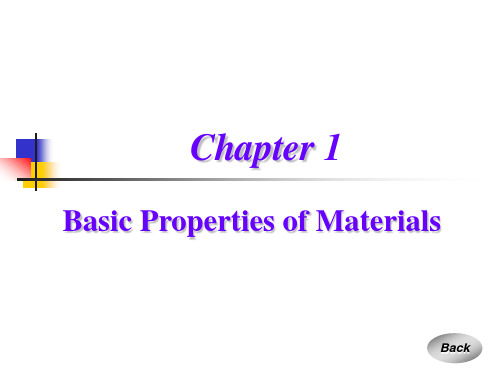
Chapter 3
Words and Phases
carbon dioxide: 二氧化碳(CO2) calcium oxide: 氧化钙(CaO) tricalcium silicate: 硅酸三钙 dicalcium silicate: 硅酸二钙 tricalcium aluminate: 铝酸三钙 tetracalcium aluminoferrite: 铁铝酸四钙 shrinkage: 收缩 calcium hydroxide: 氢氧化钙 calcium silicate hydrate: 水化硅酸钙 sulfate: 硫酸盐 Chapter 3
Chapter 4
Words and Phases
impurities: 有害杂质 mica: 云母 silt: 淤泥 organic substance: 有机物 sulphide: 硫化物 sulphate: 硫酸盐 chloride: 氯化物
Chapter 4
Words and Phases
Words and Phases
pottery陶瓷 steel 钢材 wood 木材 wetting angle 润湿角 hydrophilic property亲水性 hydrophobic property憎水性 water-absorbing quality 吸水性 water absorption吸水率 water percentage 含水率
Chapter 2
Words and Phases
dolomite ground slaked lime 白云石消石 灰粉 over-burnt lime 过火石灰 under-burnt lime 欠火石灰 crystallization 结晶 carbonization 碳化 soundness 体积安定性 water retentivity保水性 shrinkage 收缩 Chapter 2
(完整版)土木工程专业英语翻译
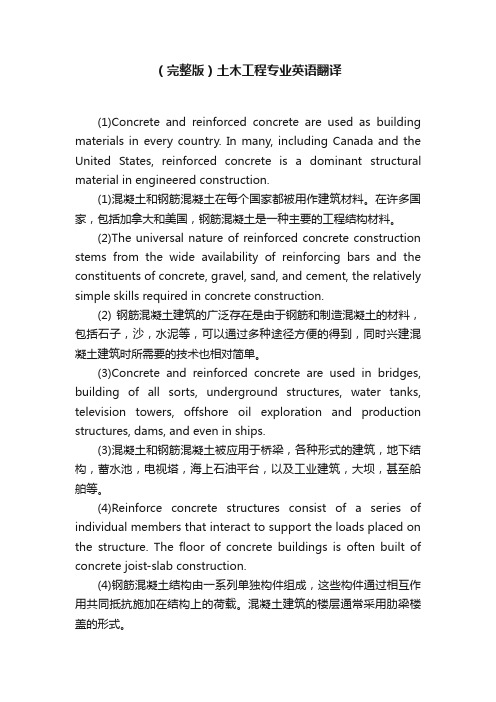
(完整版)土木工程专业英语翻译(1)Concrete and reinforced concrete are used as building materials in every country. In many, including Canada and the United States, reinforced concrete is a dominant structural material in engineered construction.(1)混凝土和钢筋混凝土在每个国家都被用作建筑材料。
在许多国家,包括加拿大和美国,钢筋混凝土是一种主要的工程结构材料。
(2)The universal nature of reinforced concrete construction stems from the wide availability of reinforcing bars and the constituents of concrete, gravel, sand, and cement, the relatively simple skills required in concrete construction.(2) 钢筋混凝土建筑的广泛存在是由于钢筋和制造混凝土的材料,包括石子,沙,水泥等,可以通过多种途径方便的得到,同时兴建混凝土建筑时所需要的技术也相对简单。
(3)Concrete and reinforced concrete are used in bridges, building of all sorts, underground structures, water tanks, television towers, offshore oil exploration and production structures, dams, and even in ships.(3)混凝土和钢筋混凝土被应用于桥梁,各种形式的建筑,地下结构,蓄水池,电视塔,海上石油平台,以及工业建筑,大坝,甚至船舶等。
土木工程专业英语课文 翻译 考试必备
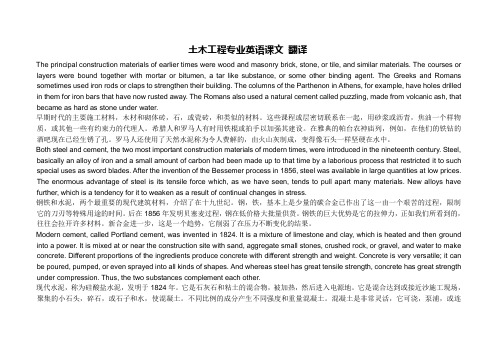
土木工程专业英语课文翻译The principal construction materials of earlier times were wood and masonry brick, stone, or tile, and similar materials. The courses or layers were bound together with mortar or bitumen, a tar like substance, or some other binding agent. The Greeks and Romans sometimes used iron rods or claps to strengthen their building. The columns of the Parthenon in Athens, for example, have holes drilled in them for iron bars that have now rusted away. The Romans also used a natural cement called puzzling, made from volcanic ash, that became as hard as stone under water.早期时代的主要施工材料,木材和砌体砖,石,或瓷砖,和类似的材料。
这些课程或层密切联系在一起,用砂浆或沥青,焦油一个样物质,或其他一些有约束力的代理人。
希腊人和罗马人有时用铁棍或拍手以加强其建设。
在雅典的帕台农神庙列,例如,在他们的铁钻的酒吧现在已经生锈了孔。
罗马人还使用了天然水泥称为令人费解的,由火山灰制成,变得像石头一样坚硬在水中。
Both steel and cement, the two most important construction materials of modern times, were introduced in the nineteenth century. Steel, basically an alloy of iron and a small amount of carbon had been made up to that time by a laborious process that restricted it to such special uses as sword blades. After the invention of the Bessemer process in 1856, steel was available in large quantities at low prices. The enormous advantage of steel is its tensile force which, as we have seen, tends to pull apart many materials. New alloys have further, which is a tendency for it to weaken as a result of continual changes in stress.钢铁和水泥,两个最重要的现代建筑材料,介绍了在十九世纪。
土木工程专业英语课文翻译陶燕王文萱第九单元
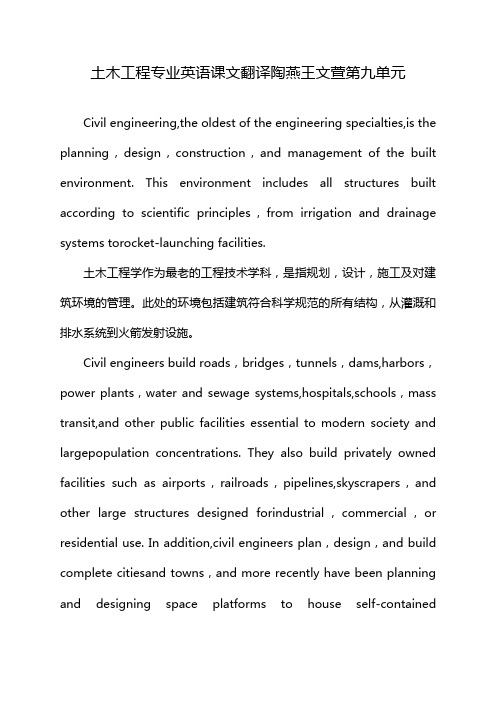
土木工程专业英语课文翻译陶燕王文萱第九单元Civil engineering,the oldest of the engineering specialties,is the planning,design,construction,and management of the built environment. This environment includes all structures built according to scientific principles,from irrigation and drainage systems torocket-launching facilities.土木工程学作为最老的工程技术学科,是指规划,设计,施工及对建筑环境的管理。
此处的环境包括建筑符合科学规范的所有结构,从灌溉和排水系统到火箭发射设施。
Civil engineers build roads,bridges,tunnels,dams,harbors,power plants,water and sewage systems,hospitals,schools,mass transit,and other public facilities essential to modern society and largepopulation concentrations. They also build privately owned facilities such as airports,railroads,pipelines,skyscrapers,and other large structures designed forindustrial,commercial,or residential use. In addition,civil engineers plan,design,and build complete citiesand towns,and more recently have been planning and designing space platforms to house self-containedcommunities.土木工程师建造道路,桥梁,管道,大坝,海港,发电厂,给排水系统,医院,学校,公共交通和其他现代社会和大量人口集中地区的基础公共设施。
土木工程专业英语原文及翻译
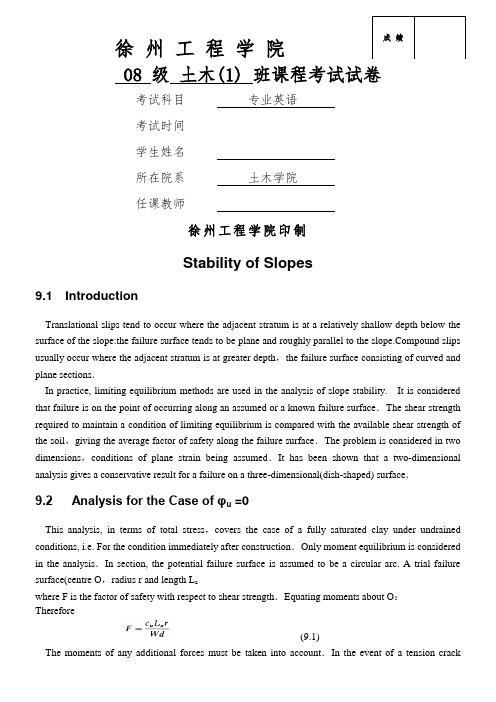
成绩徐州工程学院08 级土木(1) 班课程考试试卷考试科目专业英语考试时间学生姓名所在院系土木学院任课教师徐州工程学院印制Stability of Slopes9.1 IntroductionTranslational slips tend to occur where the adjacent stratum is at a relatively shallow depth below the surface of the slope:the failure surface tends to be plane and roughly parallel to the pound slips usually occur where the adjacent stratum is at greater depth,the failure surface consisting of curved and plane sections.In practice, limiting equilibrium methods are used in the analysis of slope stability. It is considered that failure is on the point of occurring along an assumed or a known failure surface.The shear strength required to maintain a condition of limiting equilibrium is compared with the available shear strength of the soil,giving the average factor of safety along the failure surface.The problem is considered in two dimensions,conditions of plane strain being assumed.It has been shown that a two-dimensional analysis gives a conservative result for a failure on a three-dimensional(dish-shaped) surface.9.2 Analysis for the Case of φu =0This analysis, in terms of total stress,covers the case of a fully saturated clay under undrained conditions, i.e. For the condition immediately after construction.Only moment equilibrium is considered in the analysis.In section, the potential failure surface is assumed to be a circular arc. A trial failure surface(centre O,radius r and length L awhere F is the factor of safety with respect to shear strength.Equating moments about O:Therefore(9.1)The moments of any additional forces must be taken into account.In the event of a tension crackdeveloping ,as shown in Fig.9.2,the arc length L a is shortened and a hydrostatic force will act normal to the crack if the crack fills with water.It is necessary to analyze the slope for a number of trial failure surfaces in order that the minimum factor of safety can be determined.Based on the principle of geometric similarity,Taylor[9.9]published stability coefficients for the analysis of homogeneous slopes in terms of total stress.For a slope of height H the stability coefficient (N s) for the failure surface along which the factor of safety is a minimum is(9.2)For the case ofφu =0,values of N ss depends on the slope angleβand the depth factor D,where DH is the depth to a firm stratum.Gibson and Morgenstern [9.3] published stability coefficients for slopes in normally consolidated clays in which the undrained strength c u(φu =0) varies linearly with depth.Example 9.1A 45°slope is excavated to a depth of 8 m in a deep layer of saturated clay of unit weight 19 kN/m3:the relevant shear strength parameters are c u =65 kN/m2 andφuIn Fig.9.4, the cross-sectional area ABCD is 70 m2.Weight of soil mass=70×19=1330kN/mThe centroid of ABCD is 4.5 m from O.The angle AOC is 89.5°and radius OC is 12.1 m.The arc length ABC is calculated as 18.9m.The factor of safety is given by:This is the factor of safety for the trial failure surface selected and is not necessarily the minimum factor of safety.The minimum factor of safety can be estimated by using Equation 9.2.From Fig.9.3,β=45°and assuming that D is large,the value of N s9.3 The Method of Slicesαand the height, measured on the centre-1ine,is h. The factor of safety is defined as the ratio of the available shear strength(τf)to the shear strength(τm) which must be mobilized to maintain a condition of limiting equilibrium, i.e.The factor of safety is taken to be the same for each slice,implying that there must be mutual support between slices,i.e. forces must act between the slices.The forces (per unit dimension normal to the section) acting on a slice are:1.The total weight of the slice,W=γb h (γsat where appropriate).2.The total normal force on the base,N (equal to σl).In general thisforce has two components,the effective normal force N'(equal toσ'l ) and the boundary water force U(equal to ul ),where u is the pore water pressure at the centre of the base and l is the length of the base.3.The shear force on the base,T=τm l.4.The total normal forces on the sides, E1 and E2.5.The shear forces on the sides,X1 and X2.Any external forces must also be included in the analysis.The problem is statically indeterminate and in order to obtain a solution assumptions must be made regarding the interslice forces E and X:the resulting solution for factor of safety is not exact.Considering moments about O,the sum of the moments of the shear forces T on the failure arc AC must equal the moment of the weight of the soil mass ABCD.For any slice the lever arm of W is rsinα,therefore∑Tr=∑Wr sinαNow,For an analysis in terms of effective stress,Or(9.3)where L a is the arc length AC.Equation 9.3 is exact but approximations are introduced in determining the forces N'.For a given failure arc the value of F will depend on the way in which the forces N' areestimated.The Fellenius SolutionIn this solution it is assumed that for each slice the resultant of the interslice forces is zero.The solution involves resolving the forces on each slice normal to the base,i.e.N'=WCOSα-ulHence the factor of safety in terms of effective stress (Equation 9.3) is given by(9.4)The components WCOSαand Wsinαcan be determined graphically for each slice.Alternatively,the value of αcan be measured or calculated.Again,a series of trial failure surfaces must be chosen in order to obtain the minimum factor of safety.This solution underestimates the factor of safety:the error,compared with more accurate methods of analysis,is usually within the range 5-2%.For an analysis in terms of total stress the parameters C u andφu are used and the value of u in Equation 9.4 is zero.If φu=0 ,the factor of safety is given by(9.5)As N’ does not appear in Equation 9.5 an exact value of F is obtained.The Bishop Simplified SolutionIn this solution it is assumed that the resultant forces on the sides of theslices are horizontal,i.e.X l-X2=0For equilibrium the shear force on the base of any slice isResolving forces in the vertical direction:(9.6)It is convenient to substitutel=b secαFrom Equation 9.3,after some rearrangement,(9.7)The pore water pressure can be related to the total ‘fill pressure’ at anypoint by means of the dimensionless pore pressure ratio,defined as(9.8)(γsat where appropriate).For any slice,Hence Equation 9.7 can be written:(9.9)As the factor of safety occurs on both sides of Equation 9.9,a process of successive approximation must be used to obtain a solution but convergence is rapid.Due to the repetitive nature of the calculations and the need to select an adequate number of trial failure surfaces,the method of slices is particularly suitable for solution by computer.More complex slope geometry and different soil strata can be introduced.In most problems the value of the pore pressure ratio r u is not constant over the whole failure surface but,unless there are isolated regions of high pore pressure,an average value(weighted on an area basis) is normally used in design.Again,the factor of safety determined by this method is an underestimate but the error is unlikely to exceed 7%and in most cases is less than 2%.Spencer [9.8] proposed a method of analysis in which the resultant Interslice forces are parallel and in which both force and moment equilibrium are satisfied.Spencer showed that the accuracy of the Bishop simplified method,in which only moment equilibrium is satisfied, is due to the insensitivity of the moment equation to the slope of the interslice forces.Dimensionless stability coefficients for homogeneous slopes,based on Equation 9.9,have been published by Bishop and Morgenstern [9.2].It can be shown that for a given slope angle and given soil properties th e factor of safety varies linearly with γu and can thus be expressed asF=m-nγu(9.10)where,m and n are the stability coefficients.The coefficients,m and n arefunctions ofβ,φ’,the dimensionless number c'/γand the depth factor D.Example 9.2Using the Fellenius method of slices,determine the factor of safety,in terms of effective stress,of the slope shown in Fig.9.6 for the given failure surface.The unit weight of the soil,both above and below the water table,is 20 kN/m 3 and the relevant shear strength parameters are c’=10 kN/m2andφ’=29°. W) of each slice is given byW=γbh=20×1.5×h=30h kN/mThe height h for each slice is set off below the centre of the base and thenormal and tangential components hcosαand hsinαWcosα=30h cosαW sinα=30h sinαThe pore water pressure at the centre of the base of each slice is taken to beγw z w,where z w is the vertical distance of the centre point below the water table (as shown in figure).This procedure slightly overestimates t he pore water pressure which strictly should be) γw z e,where z e is the vertical distance below the point of intersection of the water table and the equipotential through the centre of the slice base.The error involved is on the safe side.The arc length (L a) is calculated as 14.35 mm.The results are given inTable 9.1∑Wcosα=30×17.50=525kN/m∑W sinα=30×8.45=254kN/m∑(wcos α-ul)=525—132=393kN/m9.4 Analysis of a Plane Translational SlipIt is assumed that the potential failure surface is parallel to the surface of the slope and is at a depth that is small compared with the length of the slope. The slope can then be considered as being of infinite length,with end effects being ignored.The slope is inclined at angle βmz (0<m<1)above the failure plane.Steady seepage is assumed to be taking place in a direction parallel to the slope.The forces on the sides of any vertical slice are equal and opposite and the stress conditions are the same at every point on the failure plane.In terms of effective stress,the shear strength of the soil along the failure plane isand the factor of safety isThe expressions forσ,τandμare:The following special cases are of interest.If c’=0 and m=0 (i.e. the soilbetween the surface and the failure plane is not fully saturated),then(9.11)If c’=0 and m=1(i.e. the water table coincides with the surface of the slope),then:(9.12)It should be noted that when c’=0 the factor of safety is independent ofthe depth z.If c’ is greater than zero,the factor of safety is a function of z, and βmay exceedφ’ provided z is less than a critical value.For a total stress analysis the shear strength parameters c u andφu are used with a zero value of u. Example 9.3A long natural slope in a fissured overconsolidated clay is inclined at 12°to the horizontal.The water table is at the surface and seepage is roughly parallel to the slope.A slip has developed on a plane parallel to the surface at a depth of 5 m.The saturated unit weight of the clay is 20 kN/m3.The peak strength parameters are c’=10 kN/m2andφ’=26°;the residual strength parameters are c r’=0 andφr’=18°.Determine the factor of safety alo ng the slip plane(a)in terms of the peak strength parameters (b)in terms of the residual strength parameters.With the water table at the surface(m=1),at any point on the slip plane,Using the peak strength parameters,Then the factor of safety is given byUsing the residual strength parameters,the factor of safety can beobtained from Equation 9.12:9.5 General Methods of AnalysisMorgenstern and Price[9.4]developed a general analysis in which all boundary and equilibrium conditions are satisfied and in which the failure surface may be any shape,circular,non-circular or compound.The soil mass above the failure plane is divided into sections by a number of vertical planes and the problem is rendered statically determinate by assuming a relationship between the forces E and X on the vertical boundaries between each section.This assumption is of the formX=λf(x)E (9.13)where f(x)is an arbitrary function describing the pattern in which the ratio X/E varies across the soil mas s andλis a scale factor.The value ofλis obtained as part of the solution along with the factor of safety F.The values of the forces E and X and the point of application of E can be determined at each vertical boundary.For any assumed function f(x) it is necessary to examine the solution in detail to ensure that it is physically reasonable (i.e. no shear failure or tension must be implied within the soil mass above the failure surface). The choice of the function f(x) does not appear to influence the computed value of F by more than about 5% and f(x)=l is a common assumption.The analysis involves a complex process of iteration for the values ofλ and F,described byMorgenstern and Price[9.5],and the use of a computer is essential.Bell [9.1] proposed a method of analysis in which all the conditions of equilibrium are satisfied and the assumed failure surface may be of any shape.The soil mass is divided into a number of vertical slices and statical determinacy is obtained by means of an assumed distribution of normal stress along the failure surface.Sarma [9.6] developed a method,based on the method of slices,in which the critical earthquake acceleration required to produce a condition of limiting equilibrium is determined.An assumed distribution of vertical interslice forces is used in the analysis.Again,all the conditions of equilibrium are satisfied and the assumed failure surface may be of any shape.The static factor of safety is the factor by which the shear strength of the soil must be reduced such that the critical acceleration is zero.The use of a computer is also essential for the Bell and Sarma methods and all solutions must be checked to ensure that they are physically acceptable.References[9.1]Bell,J,M.(1968):’General Slope Stability Analysis’, Journal ASCE,V01.94,No.SM6.:‘Stability Coefficients for Earth Slopes Geotechnique,.’,Vo1.1 5,No.1.‘A Numerical Method for Solving the Equations of Stability of General Slip Surfaces’Computer Journal,Voi.9,P.388.[9.6]Sarma,S.K. (1973):’Stability Analysis of Embankments and Slopes’,Geotechnique,Vo1.23,No.2.[9.7]Skempton,A.W.(1970):’First-Time Slides in Overconsolidated Clays’(Technical Note),[9.8]Spencer,E.(1 967):‘A Method of Analysis of the Stability of Embankments Assuming Parallel Inter-SliceForces’,Geotechnique,.[9.9]Taylor,D.W.(1937):’Stability of Earth Slopes’,Journal of the Boston Society of Civil Engineers,Vo1.24,No.3边坡稳定9.1 引言重力和渗透力易引起天然边坡、开挖形成的边坡、堤防边坡和土坝的不稳定性。
土木工程专业英语带译文

Chapter 6
If a material with high strength in tension, such as steel, is placed in concrete, then the composite material, reinforced concrete, resists not only compression but also bending and other direct tensile actions. A reinforced concrete section where the concrete resists the compression and steel resists the tension can be made into almost any shape and size for the construction industry.
6. —We shall finish the civil work by the end of the year. 在年底前我们将完成土建工作。 —Cement steel and timber are the most important construction materials used in civil engineering. 水泥、钢材和木材是土建工程中最重要的建筑材料。 7. These are the anchor bolts (rivets, unfinished bolts, high-strength structural bolts) for the structure. 这是用于结构的锚定螺栓(铆钉、粗制螺栓、高强度结构用螺栓)。
Chapter 6
Chapter 6 Reinforced Concrete
土木工程专业英语(苏小卒版)翻译.
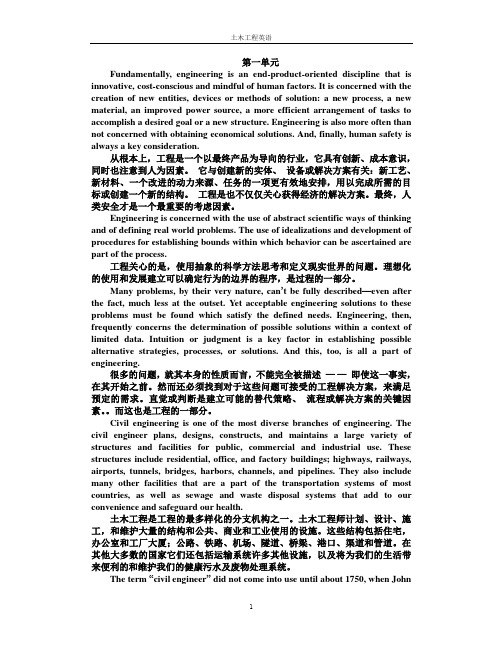
第一单元Fundamentally, engineering is an end-product-oriented discipline that is innovative, cost-conscious and mindful of human factors. It is concerned with the creation of new entities, devices or methods of solution: a new process, a new material, an improved power source, a more efficient arrangement of tasks to accomplish a desired goal or a new structure. Engineering is also more often than not concerned with obtaining economical solutions. And, finally, human safety is always a key consideration.从根本上,工程是一个以最终产品为导向的行业,它具有创新、成本意识,同时也注意到人为因素。
它与创建新的实体、设备或解决方案有关:新工艺、新材料、一个改进的动力来源、任务的一项更有效地安排,用以完成所需的目标或创建一个新的结构。
工程是也不仅仅关心获得经济的解决方案。
最终,人类安全才是一个最重要的考虑因素。
Engineering is concerned with the use of abstract scientific ways of thinking and of defining real world problems. The use of idealizations and development of procedures for establishing bounds within which behavior can be ascertained are part of the process.工程关心的是,使用抽象的科学方法思考和定义现实世界的问题。
土木工程专业英语课后翻译

一.1.受压构件是只承受轴向压力的结构构件。
Compression members are those structural elements that are subjected only to axial compressive forces.2.公式1.1要成立,构件必须是弹性的并且其两端能自由转动但不能横向移动。
For Eq.1.1 to be valid,the member must be elastic,and it's ends must be free to rotate but not translate laterally.3.临界荷载有时被称为欧拉荷载或欧拉屈服荷载。
The critical load is sometimes referred to as the Euler load or the Euler buckling load.4.图1.2中的应力-应变曲线不同于延性钢的应力-应变曲线,因为它有明显的非线性区域。
The stress-strain curve in Fig.1.2 is differet from the ones for ductile steel because it has a pronounced region of nonlinearity.5.其他因素,像焊接和冷弯,都能影响残余应力,但冷却过程是残余应力的主要来源。
Other factors,such as welding and cold bending to create curvature in a beam, can contribute to be the residual stress,but the cooling process is the chief source.二1。
作用在结构上的力被称为荷载The forces that act on a structure are called loads.2.恒载就是固定不变的荷载,包括结构自身的重量。
土木工程专业英语课文原文及对照翻译
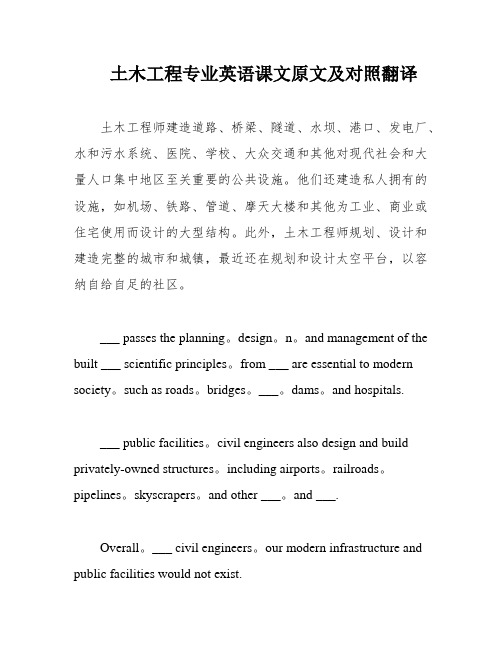
土木工程专业英语课文原文及对照翻译土木工程师建造道路、桥梁、隧道、水坝、港口、发电厂、水和污水系统、医院、学校、大众交通和其他对现代社会和大量人口集中地区至关重要的公共设施。
他们还建造私人拥有的设施,如机场、铁路、管道、摩天大楼和其他为工业、商业或住宅使用而设计的大型结构。
此外,土木工程师规划、设计和建造完整的城市和城镇,最近还在规划和设计太空平台,以容纳自给自足的社区。
___ passes the planning。
design。
n。
and management of the built ___ scientific principles。
from ___ are essential to modern society。
such as roads。
bridges。
___。
dams。
and hospitals.___ public facilities。
civil engineers also design and build privately-owned structures。
including airports。
railroads。
pipelines。
skyscrapers。
and other ___。
and ___.Overall。
___ civil engineers。
our modern infrastructure and public facilities would not exist.___。
n。
and maintenance of public and private infrastructure。
This includes roads。
bridges。
pipelines。
dams。
ports。
power plants。
water supply and sewage systems。
hospitals。
schools。
___。
and other structures that are essential to modern ___ as airports。
《土木工程专业英语》陈瑛邵永波主编全文经典翻译
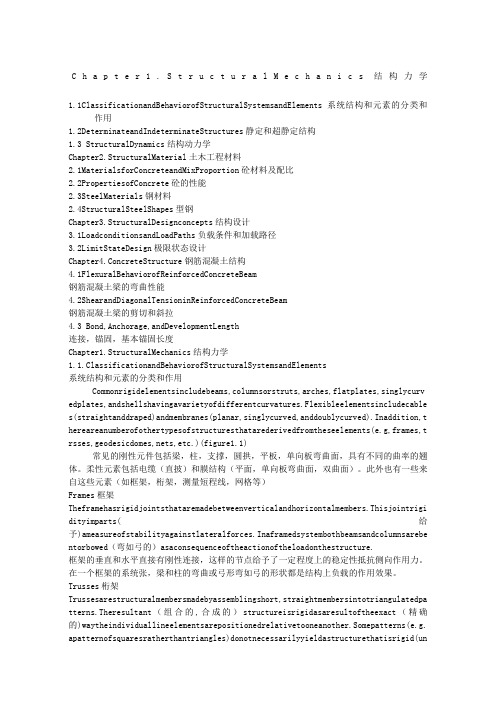
C h a p t e r1.S t r u c t u r a l M e c h a n i c s结构力学1.1ClassificationandBehaviorofStructuralSystemsandElements系统结构和元素的分类和作用1.2DeterminateandIndeterminateStructures静定和超静定结构1.3 StructuralDynamics结构动力学Chapter2.StructuralMaterial土木工程材料2.1MaterialsforConcreteandMixProportion砼材料及配比2.2PropertiesofConcrete砼的性能2.3SteelMaterials钢材料2.4StructuralSteelShapes型钢Chapter3.StructuralDesignconcepts结构设计3.1LoadconditionsandLoadPaths负载条件和加载路径3.2LimitStateDesign极限状态设计Chapter4.ConcreteStructure钢筋混凝土结构4.1FlexuralBehaviorofReinforcedConcreteBeam钢筋混凝土梁的弯曲性能4.2ShearandDiagonalTensioninReinforcedConcreteBeam钢筋混凝土梁的剪切和斜拉4.3 Bond,Anchorage,andDevelopmentLength连接,锚固,基本锚固长度Chapter1.StructuralMechanics结构力学1.1.ClassificationandBehaviorofStructuralSystemsandElements系统结构和元素的分类和作用Commonrigidelementsincludebeams,columnsorstruts,arches,flatplates,singlycurv edplates,andshellshavingavarietyofdifferentcurvatures.Flexibleelementsincludecable s(straightanddraped)andmembranes(planar,singlycurved,anddoublycurved).Inaddition,t hereareanumberofothertypesofstructuresthatarederivedfromtheseelements(e.g,frames,t rsses,geodesicdomes,nets,etc.)(figure1.1)常见的刚性元件包括梁,柱,支撑,圆拱,平板,单向板弯曲面,具有不同的曲率的翘体。
土木工程 专业外语词汇大全中英翻译
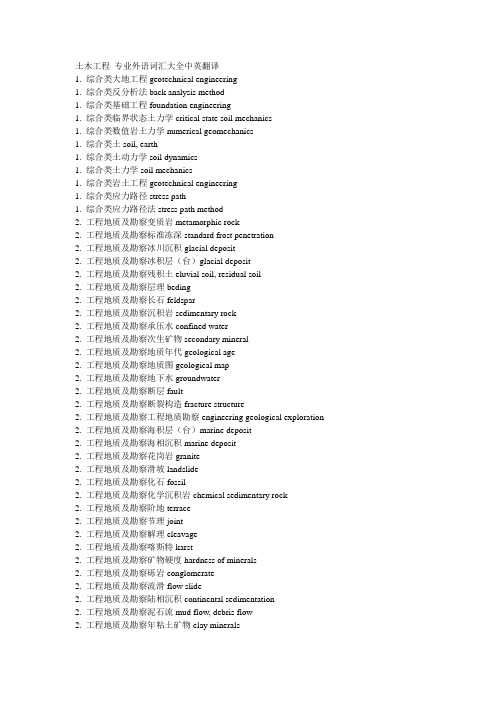
土木工程专业外语词汇大全中英翻译1. 综合类大地工程geotechnical engineering1. 综合类反分析法back analysis method1. 综合类基础工程foundation engineering1. 综合类临界状态土力学critical state soil mechanics1. 综合类数值岩土力学numerical geomechanics1. 综合类土soil, earth1. 综合类土动力学soil dynamics1. 综合类土力学soil mechanics1. 综合类岩土工程geotechnical engineering1. 综合类应力路径stress path1. 综合类应力路径法stress path method2. 工程地质及勘察变质岩metamorphic rock2. 工程地质及勘察标准冻深standard frost penetration2. 工程地质及勘察冰川沉积glacial deposit2. 工程地质及勘察冰积层(台)glacial deposit2. 工程地质及勘察残积土eluvial soil, residual soil2. 工程地质及勘察层理beding2. 工程地质及勘察长石feldspar2. 工程地质及勘察沉积岩sedimentary rock2. 工程地质及勘察承压水confined water2. 工程地质及勘察次生矿物secondary mineral2. 工程地质及勘察地质年代geological age2. 工程地质及勘察地质图geological map2. 工程地质及勘察地下水groundwater2. 工程地质及勘察断层fault2. 工程地质及勘察断裂构造fracture structure2. 工程地质及勘察工程地质勘察engineering geological exploration 2. 工程地质及勘察海积层(台)marine deposit2. 工程地质及勘察海相沉积marine deposit2. 工程地质及勘察花岗岩granite2. 工程地质及勘察滑坡landslide2. 工程地质及勘察化石fossil2. 工程地质及勘察化学沉积岩chemical sedimentary rock2. 工程地质及勘察阶地terrace2. 工程地质及勘察节理joint2. 工程地质及勘察解理cleavage2. 工程地质及勘察喀斯特karst2. 工程地质及勘察矿物硬度hardness of minerals2. 工程地质及勘察砾岩conglomerate2. 工程地质及勘察流滑flow slide2. 工程地质及勘察陆相沉积continental sedimentation2. 工程地质及勘察泥石流mud flow, debris flow2. 工程地质及勘察年粘土矿物clay minerals2. 工程地质及勘察凝灰岩tuff2. 工程地质及勘察牛轭湖ox-bow lake2. 工程地质及勘察浅成岩hypabyssal rock2. 工程地质及勘察潜水ground water2. 工程地质及勘察侵入岩intrusive rock2. 工程地质及勘察取土器geotome2. 工程地质及勘察砂岩sandstone2. 工程地质及勘察砂嘴spit, sand spit2. 工程地质及勘察山岩压力rock pressure2. 工程地质及勘察深成岩plutionic rock2. 工程地质及勘察石灰岩limestone2. 工程地质及勘察石英quartz2. 工程地质及勘察松散堆积物rickle2. 工程地质及勘察围限地下水(台)confined ground water 2. 工程地质及勘察泻湖lagoon2. 工程地质及勘察岩爆rock burst2. 工程地质及勘察岩层产状attitude of rock2. 工程地质及勘察岩浆岩magmatic rock, igneous rock2. 工程地质及勘察岩脉dike, dgke2. 工程地质及勘察岩石风化程度degree of rock weathering 2. 工程地质及勘察岩石构造structure of rock2. 工程地质及勘察岩石结构texture of rock2. 工程地质及勘察岩体rock mass2. 工程地质及勘察页岩shale2. 工程地质及勘察原生矿物primary mineral2. 工程地质及勘察云母mica2. 工程地质及勘察造岩矿物rock-forming mineral2. 工程地质及勘察褶皱fold, folding2. 工程地质及勘察钻孔柱状图bore hole columnar section3. 土的分类饱和土saturated soil3. 土的分类超固结土overconsolidated soil3. 土的分类冲填土dredger fill3. 土的分类充重塑土3. 土的分类冻土frozen soil, tjaele3. 土的分类非饱和土unsaturated soil3. 土的分类分散性土dispersive soil3. 土的分类粉土silt, mo3. 土的分类粉质粘土silty clay3. 土的分类高岭石kaolinite3. 土的分类过压密土(台)overconsolidated soil3. 土的分类红粘土red clay, adamic earth3. 土的分类黄土loess, huangtu(China)3. 土的分类蒙脱石montmorillonite3. 土的分类泥炭peat, bog muck3. 土的分类年粘土clay3. 土的分类年粘性土cohesive soil, clayey soil3. 土的分类膨胀土expansive soil, swelling soil3. 土的分类欠固结粘土underconsolidated soil3. 土的分类区域性土zonal soil3. 土的分类人工填土fill, artificial soil3. 土的分类软粘土soft clay, mildclay, mickle3. 土的分类砂土sand3. 土的分类湿陷性黄土collapsible loess, slumping loess3. 土的分类素填土plain fill3. 土的分类塑性图plasticity chart3. 土的分类碎石土stone, break stone, broken stone, channery, chat, crushed stone, deritus 3. 土的分类未压密土(台)underconsolidated clay3. 土的分类无粘性土cohesionless soil, frictional soil, non-cohesive soil3. 土的分类岩石rock3. 土的分类伊利土illite3. 土的分类有机质土organic soil3. 土的分类淤泥muck, gyttja, mire, slush3. 土的分类淤泥质土mucky soil3. 土的分类原状土undisturbed soil3. 土的分类杂填土miscellaneous fill3. 土的分类正常固结土normally consolidated soil3. 土的分类正常压密土(台)normally consolidated soil3. 土的分类自重湿陷性黄土self weight collapse loess4. 土的物理性质阿太堡界限Atterberg limits4. 土的物理性质饱和度degree of saturation4. 土的物理性质饱和密度saturated density4. 土的物理性质饱和重度saturated unit weight4. 土的物理性质比重specific gravity4. 土的物理性质稠度consistency4. 土的物理性质不均匀系数coefficient of uniformity, uniformity coefficient4. 土的物理性质触变thixotropy4. 土的物理性质单粒结构single-grained structure4. 土的物理性质蜂窝结构honeycomb structure4. 土的物理性质干重度dry unit weight4. 土的物理性质干密度dry density4. 土的物理性质塑性指数plasticity index4. 土的物理性质含水量water content, moisture content4. 土的物理性质活性指数4. 土的物理性质级配gradation, grading4. 土的物理性质结合水bound water, combined water, held water4. 土的物理性质界限含水量Atterberg limits4. 土的物理性质颗粒级配particle size distribution of soils, mechanical composition of soil 4. 土的物理性质可塑性plasticity4. 土的物理性质孔隙比void ratio4. 土的物理性质孔隙率porosity4. 土的物理性质粒度granularity, grainness, grainage4. 土的物理性质粒组fraction, size fraction4. 土的物理性质毛细管水capillary water4. 土的物理性质密度density4. 土的物理性质密实度compactionness4. 土的物理性质年粘性土的灵敏度sensitivity of cohesive soil4. 土的物理性质平均粒径mean diameter, average grain diameter4. 土的物理性质曲率系数coefficient of curvature4. 土的物理性质三相图block diagram, skeletal diagram, three phase diagram4. 土的物理性质三相土tri-phase soil4. 土的物理性质湿陷起始应力initial collapse pressure4. 土的物理性质湿陷系数coefficient of collapsibility4. 土的物理性质缩限shrinkage limit4. 土的物理性质土的构造soil texture4. 土的物理性质土的结构soil structure4. 土的物理性质土粒相对密度specific density of solid particles4. 土的物理性质土中气air in soil4. 土的物理性质土中水water in soil4. 土的物理性质团粒aggregate, cumularpharolith4. 土的物理性质限定粒径constrained diameter4. 土的物理性质相对密度relative density, density index4. 土的物理性质相对压密度relative compaction, compacting factor, percent compaction, coefficient of compaction4. 土的物理性质絮状结构flocculent structure4. 土的物理性质压密系数coefficient of consolidation4. 土的物理性质压缩性compressibility4. 土的物理性质液限liquid limit4. 土的物理性质液性指数liquidity index4. 土的物理性质游离水(台)free water4. 土的物理性质有效粒径effective diameter, effective grain size, effective size4. 土的物理性质有效密度effective density4. 土的物理性质有效重度effective unit weight4. 土的物理性质重力密度unit weight4. 土的物理性质自由水free water, gravitational water, groundwater, phreatic water4. 土的物理性质组构fabric4. 土的物理性质最大干密度maximum dry density4. 土的物理性质最优含水量optimum water content5. 渗透性和渗流达西定律Darcy s law5. 渗透性和渗流管涌piping5. 渗透性和渗流浸润线phreatic line5. 渗透性和渗流临界水力梯度critical hydraulic gradient5. 渗透性和渗流流函数flow function5. 渗透性和渗流流土flowing soil5. 渗透性和渗流流网flow net5. 渗透性和渗流砂沸sand boiling5. 渗透性和渗流渗流seepage5. 渗透性和渗流渗流量seepage discharge5. 渗透性和渗流渗流速度seepage velocity5. 渗透性和渗流渗透力seepage force5. 渗透性和渗流渗透破坏seepage failure5. 渗透性和渗流渗透系数coefficient of permeability5. 渗透性和渗流渗透性permeability5. 渗透性和渗流势函数potential function5. 渗透性和渗流水力梯度hydraulic gradient6. 地基应力和变形变形deformation6. 地基应力和变形变形模量modulus of deformation6. 地基应力和变形泊松比Poisson s ratio6. 地基应力和变形布西涅斯克解Boussinnesq s solution6. 地基应力和变形残余变形residual deformation6. 地基应力和变形残余孔隙水压力residual pore water pressure6. 地基应力和变形超静孔隙水压力excess pore water pressure6. 地基应力和变形沉降settlement6. 地基应力和变形沉降比settlement ratio6. 地基应力和变形次固结沉降secondary consolidation settlement6. 地基应力和变形次固结系数coefficient of secondary consolidation6. 地基应力和变形地基沉降的弹性力学公式elastic formula for settlement calculation 6. 地基应力和变形分层总和法layerwise summation method6. 地基应力和变形负孔隙水压力negative pore water pressure6. 地基应力和变形附加应力superimposed stress6. 地基应力和变形割线模量secant modulus6. 地基应力和变形固结沉降consolidation settlement6. 地基应力和变形规范沉降计算法settlement calculation by specification6. 地基应力和变形回弹变形rebound deformation6. 地基应力和变形回弹模量modulus of resilience6. 地基应力和变形回弹系数coefficient of resilience6. 地基应力和变形回弹指数swelling index6. 地基应力和变形建筑物的地基变形允许值allowable settlement of building6. 地基应力和变形剪胀dilatation6. 地基应力和变形角点法corner-points method6. 地基应力和变形孔隙气压力pore air pressure6. 地基应力和变形孔隙水压力pore water pressure6. 地基应力和变形孔隙压力系数Apore pressure parameter A6. 地基应力和变形孔隙压力系数Bpore pressure parameter B6. 地基应力和变形明德林解Mindlin s solution6. 地基应力和变形纽马克感应图Newmark chart6. 地基应力和变形切线模量tangent modulus6. 地基应力和变形蠕变creep6. 地基应力和变形三向变形条件下的固结沉降three-dimensional consolidation settlement 6. 地基应力和变形瞬时沉降immediate settlement6. 地基应力和变形塑性变形plastic deformation6. 地基应力和变形谈弹性变形elastic deformation6. 地基应力和变形谈弹性模量elastic modulus6. 地基应力和变形谈弹性平衡状态state of elastic equilibrium6. 地基应力和变形体积变形模量volumetric deformation modulus6. 地基应力和变形先期固结压力preconsolidation pressure6. 地基应力和变形压缩层6. 地基应力和变形压缩模量modulus of compressibility6. 地基应力和变形压缩系数coefficient of compressibility6. 地基应力和变形压缩性compressibility6. 地基应力和变形压缩指数compression index6. 地基应力和变形有效应力effective stress6. 地基应力和变形自重应力self-weight stress6. 地基应力和变形总应力total stress approach of shear strength6. 地基应力和变形最终沉降final settlement7. 固结巴隆固结理论Barron s consolidation theory7. 固结比奥固结理论Biot s consolidation theory7. 固结超固结比over-consolidation ratio7. 固结超静孔隙水压力excess pore water pressure7. 固结次固结secondary consolidation7. 固结次压缩(台)secondary consolidatin7. 固结单向度压密(台)one-dimensional consolidation7. 固结多维固结multi-dimensional consolidation7. 固结固结consolidation7. 固结固结度degree of consolidation7. 固结固结理论theory of consolidation7. 固结固结曲线consolidation curve7. 固结固结速率rate of consolidation7. 固结固结系数coefficient of consolidation7. 固结固结压力consolidation pressure7. 固结回弹曲线rebound curve7. 固结井径比drain spacing ratio7. 固结井阻well resistance7. 固结曼代尔-克雷尔效应Mandel-Cryer effect7. 固结潜变(台)creep7. 固结砂井sand drain7. 固结砂井地基平均固结度average degree of consolidation of sand-drained ground7. 固结时间对数拟合法logrithm of time fitting method7. 固结时间因子time factor7. 固结太沙基固结理论Terzaghi s consolidation theory7. 固结太沙基-伦杜列克扩散方程Terzaghi-Rendulic diffusion equation7. 固结先期固结压力preconsolidation pressure7. 固结压密(台)consolidation7. 固结压密度(台)degree of consolidation7. 固结压缩曲线cpmpression curve7. 固结一维固结one dimensional consolidation7. 固结有效应力原理principle of effective stress7. 固结预压密压力(台)preconsolidation pressure7. 固结原始压缩曲线virgin compression curve7. 固结再压缩曲线recompression curve7. 固结主固结primary consolidation7. 固结主压密(台)primary consolidation7. 固结准固结压力pseudo-consolidation pressure7. 固结K0固结consolidation under K0 condition8. 抗剪强度安息角(台)angle of repose8. 抗剪强度不排水抗剪强度undrained shear strength8. 抗剪强度残余内摩擦角residual angle of internal friction8. 抗剪强度残余强度residual strength8. 抗剪强度长期强度long-term strength8. 抗剪强度单轴抗拉强度uniaxial tension test8. 抗剪强度动强度dynamic strength of soils8. 抗剪强度峰值强度peak strength8. 抗剪强度伏斯列夫参数Hvorslev parameter8. 抗剪强度剪切应变速率shear strain rate8. 抗剪强度抗剪强度shear strength8. 抗剪强度抗剪强度参数shear strength parameter8. 抗剪强度抗剪强度有效应力法effective stress approach of shear strength 8. 抗剪强度抗剪强度总应力法total stress approach of shear strength8. 抗剪强度库仑方程Coulomb s equation8. 抗剪强度摩尔包线Mohr s envelope8. 抗剪强度摩尔-库仑理论Mohr-Coulomb theory8. 抗剪强度内摩擦角angle of internal friction8. 抗剪强度年粘聚力cohesion8. 抗剪强度破裂角angle of rupture8. 抗剪强度破坏准则failure criterion8. 抗剪强度十字板抗剪强度vane strength8. 抗剪强度无侧限抗压强度unconfined compression strength8. 抗剪强度有效内摩擦角effective angle of internal friction8. 抗剪强度有效粘聚力effective cohesion intercept8. 抗剪强度有效应力破坏包线effective stress failure envelope8. 抗剪强度有效应力强度参数effective stress strength parameter8. 抗剪强度有效应力原理principle of effective stress8. 抗剪强度真内摩擦角true angle internal friction8. 抗剪强度真粘聚力true cohesion8. 抗剪强度总应力破坏包线total stress failure envelope8. 抗剪强度总应力强度参数total stress strength parameter9. 本构模型本构模型constitutive model9. 本构模型边界面模型boundary surface model9. 本构模型层向各向同性体模型cross anisotropic model9. 本构模型超弹性模型hyperelastic model9. 本构模型德鲁克-普拉格准则Drucker-Prager criterion9. 本构模型邓肯-张模型Duncan-Chang model9. 本构模型动剪切强度9. 本构模型非线性弹性模量nonlinear elastic model9. 本构模型盖帽模型cap model9. 本构模型刚塑性模型rigid plastic model9. 本构模型割线模量secant modulus9. 本构模型广义冯·米赛斯屈服准则extended von Mises yield criterion 9. 本构模型广义特雷斯卡屈服准则extended tresca yield criterion9. 本构模型加工软化work softening9. 本构模型加工硬化work hardening9. 本构模型加工硬化定律strain harding law9. 本构模型剑桥模型Cambridge model9. 本构模型柯西弹性模型Cauchy elastic model9. 本构模型拉特-邓肯模型Lade-Duncan model9. 本构模型拉特屈服准则Lade yield criterion9. 本构模型理想弹塑性模型ideal elastoplastic model9. 本构模型临界状态弹塑性模型critical state elastoplastic model9. 本构模型流变学模型rheological model9. 本构模型流动规则flow rule9. 本构模型摩尔-库仑屈服准则Mohr-Coulomb yield criterion9. 本构模型内蕴时间塑性模型endochronic plastic model9. 本构模型内蕴时间塑性理论endochronic theory9. 本构模型年粘弹性模型viscoelastic model9. 本构模型切线模量tangent modulus9. 本构模型清华弹塑性模型Tsinghua elastoplastic model9. 本构模型屈服面yield surface9. 本构模型沈珠江三重屈服面模型Shen Zhujiang three yield surface method 9. 本构模型双参数地基模型9. 本构模型双剪应力屈服模型twin shear stress yield criterion9. 本构模型双曲线模型hyperbolic model9. 本构模型松岗元-中井屈服准则Matsuoka-Nakai yield criterion9. 本构模型塑性形变理论9. 本构模型谈弹塑性模量矩阵elastoplastic modulus matrix9. 本构模型谈弹塑性模型elastoplastic modulus9. 本构模型谈弹塑性增量理论incremental elastoplastic theory9. 本构模型谈弹性半空间地基模型elastic half-space foundation model9. 本构模型谈弹性变形elastic deformation9. 本构模型谈弹性模量elastic modulus9. 本构模型谈弹性模型elastic model9. 本构模型魏汝龙-Khosla-Wu模型Wei Rulong-Khosla-Wu model9. 本构模型文克尔地基模型Winkler foundation model9. 本构模型修正剑桥模型modified cambridge model9. 本构模型准弹性模型hypoelastic model10. 地基承载力冲剪破坏punching shear failure10. 地基承载力次层(台)substratum10. 地基承载力地基subgrade, ground, foundation soil10. 地基承载力地基承载力bearing capacity of foundation soil10. 地基承载力地基极限承载力ultimate bearing capacity of foundation soil10. 地基承载力地基允许承载力allowable bearing capacity of foundation soil10. 地基承载力地基稳定性stability of foundation soil10. 地基承载力汉森地基承载力公式Hansen s ultimate bearing capacity formula10. 地基承载力极限平衡状态state of limit equilibrium10. 地基承载力加州承载比(美国)California Bearing Ratio10. 地基承载力局部剪切破坏local shear failure10. 地基承载力临塑荷载critical edge pressure10. 地基承载力梅耶霍夫极限承载力公式Meyerhof s ultimate bearing capacity formula 10. 地基承载力普朗特承载力理论Prandel bearing capacity theory10. 地基承载力斯肯普顿极限承载力公式Skempton s ultimate bearing capacity formula 10. 地基承载力太沙基承载力理论Terzaghi bearing capacity theory10. 地基承载力魏锡克极限承载力公式V esic s ultimate bearing capacity formula10. 地基承载力整体剪切破坏general shear failure11. 土压力被动土压力passive earth pressure11. 土压力被动土压力系数coefficient of passive earth pressure11. 土压力极限平衡状态state of limit equilibrium11. 土压力静止土压力earth pressue at rest11. 土压力静止土压力系数coefficient of earth pressur at rest11. 土压力库仑土压力理论Coulomb s earth pressure theory11. 土压力库尔曼图解法Culmannn construction11. 土压力朗肯土压力理论Rankine s earth pressure theory11. 土压力朗肯状态Rankine state11. 土压力谈弹性平衡状态state of elastic equilibrium11. 土压力土压力earth pressure11. 土压力主动土压力active earth pressure11. 土压力主动土压力系数coefficient of active earth pressure12. 土坡稳定分析安息角(台)angle of repose12. 土坡稳定分析毕肖普法Bishop method12. 土坡稳定分析边坡稳定安全系数safety factor of slope12. 土坡稳定分析不平衡推理传递法unbalanced thrust transmission method12. 土坡稳定分析费伦纽斯条分法Fellenius method of slices12. 土坡稳定分析库尔曼法Culmann method12. 土坡稳定分析摩擦圆法friction circle method12. 土坡稳定分析摩根斯坦-普拉斯法Morgenstern-Price method12. 土坡稳定分析铅直边坡的临界高度critical height of vertical slope12. 土坡稳定分析瑞典圆弧滑动法Swedish circle method12. 土坡稳定分析斯宾赛法Spencer method12. 土坡稳定分析泰勒法Taylor method12. 土坡稳定分析条分法slice method12. 土坡稳定分析土坡slope12. 土坡稳定分析土坡稳定分析slope stability analysis12. 土坡稳定分析土坡稳定极限分析法limit analysis method of slope stability 12. 土坡稳定分析土坡稳定极限平衡法limit equilibrium method of slope stability 12. 土坡稳定分析休止角angle of repose12. 土坡稳定分析扬布普遍条分法Janbu general slice method12. 土坡稳定分析圆弧分析法circular arc analysis13. 土的动力性质比阻尼容量specific gravity capacity13. 土的动力性质波的弥散特性dispersion of waves13. 土的动力性质波速法wave velocity method13. 土的动力性质材料阻尼material damping13. 土的动力性质初始液化initial liquefaction13. 土的动力性质地基固有周期natural period of soil site13. 土的动力性质动剪切模量dynamic shear modulus of soils13. 土的动力性质动力布西涅斯克解dynamic solution of Boussinesq13. 土的动力性质动力放大因素dynamic magnification factor13. 土的动力性质动力性质dynamic properties of soils13. 土的动力性质动强度dynamic strength of soils13. 土的动力性质骨架波akeleton waves in soils13. 土的动力性质几何阻尼geometric damping13. 土的动力性质抗液化强度liquefaction stress13. 土的动力性质孔隙流体波fluid wave in soil13. 土的动力性质损耗角loss angle13. 土的动力性质往返活动性reciprocating activity13. 土的动力性质无量纲频率dimensionless frequency13. 土的动力性质液化liquefaction13. 土的动力性质液化势评价evaluation of liquefaction potential13. 土的动力性质液化应力比stress ratio of liquefaction13. 土的动力性质应力波stress waves in soils13. 土的动力性质振陷dynamic settlement13. 土的动力性质阻尼damping of soil13. 土的动力性质阻尼比damping ratio14. 挡土墙挡土墙retaining wall14. 挡土墙挡土墙排水设施14. 挡土墙挡土墙稳定性stability of retaining wall14. 挡土墙垛式挡土墙14. 挡土墙扶垛式挡土墙counterfort retaining wall14. 挡土墙后垛墙(台)counterfort retaining wall14. 挡土墙基础墙foundation wall14. 挡土墙加筋土挡墙reinforced earth bulkhead14. 挡土墙锚定板挡土墙anchored plate retaining wall14. 挡土墙锚定式板桩墙anchored sheet pile wall14. 挡土墙锚杆式挡土墙anchor rod retaining wall14. 挡土墙悬壁式板桩墙cantilever sheet pile wall14. 挡土墙悬壁式挡土墙cantilever sheet pile wall14. 挡土墙重力式挡土墙gravity retaining wall15. 板桩结构物板桩sheet pile15. 板桩结构物板桩结构sheet pile structure15. 板桩结构物钢板桩steel sheet pile15. 板桩结构物钢筋混凝土板桩reinforced concrete sheet pile15. 板桩结构物钢桩steel pile15. 板桩结构物灌注桩cast-in-place pile15. 板桩结构物拉杆tie rod15. 板桩结构物锚定式板桩墙anchored sheet pile wall15. 板桩结构物锚固技术anchoring15. 板桩结构物锚座Anchorage15. 板桩结构物木板桩wooden sheet pile15. 板桩结构物木桩timber piles15. 板桩结构物悬壁式板桩墙cantilever sheet pile wall16. 基坑开挖与降水板桩围护sheet pile-braced cuts16. 基坑开挖与降水电渗法electro-osmotic drainage16. 基坑开挖与降水管涌piping16. 基坑开挖与降水基底隆起heave of base16. 基坑开挖与降水基坑降水dewatering16. 基坑开挖与降水基坑失稳instability (failure) of foundation pit16. 基坑开挖与降水基坑围护bracing of foundation pit16. 基坑开挖与降水减压井relief well16. 基坑开挖与降水降低地下水位法dewatering method16. 基坑开挖与降水井点系统well point system16. 基坑开挖与降水喷射井点eductor well point16. 基坑开挖与降水铅直边坡的临界高度critical height of vertical slope 16. 基坑开挖与降水砂沸sand boiling16. 基坑开挖与降水深井点deep well point16. 基坑开挖与降水真空井点vacuum well point16. 基坑开挖与降水支撑围护braced cuts17. 浅基础杯形基础17. 浅基础补偿性基础compensated foundation17. 浅基础持力层bearing stratum17. 浅基础次层(台)substratum17. 浅基础单独基础individual footing17. 浅基础倒梁法inverted beam method17. 浅基础刚性角pressure distribution angle of masonary foundation 17. 浅基础刚性基础rigid foundation17. 浅基础高杯口基础17. 浅基础基础埋置深度embeded depth of foundation17. 浅基础基床系数coefficient of subgrade reaction17. 浅基础基底附加应力net foundation pressure17. 浅基础交叉条形基础cross strip footing17. 浅基础接触压力contact pressure17. 浅基础静定分析法(浅基础)static analysis (shallow foundation)17. 浅基础壳体基础shell foundation17. 浅基础扩展基础spread footing17. 浅基础片筏基础mat foundation17. 浅基础浅基础shallow foundation17. 浅基础墙下条形基础17. 浅基础热摩奇金法Zemochkin s method17. 浅基础柔性基础flexible foundation17. 浅基础上部结构-基础-土共同作用分析structure- foundation-soil interactionanalysis 17. 浅基础谈弹性地基梁(板)分析analysis of beams and slabs on elastic foundation 17. 浅基础条形基础strip footing17. 浅基础下卧层substratum17. 浅基础箱形基础box foundation17. 浅基础柱下条形基础18. 深基础贝诺托灌注桩Benoto cast-in-place pile18. 深基础波动方程分析Wave equation analysis18. 深基础场铸桩(台)cast-in-place pile18. 深基础沉管灌注桩diving casting cast-in-place pile18. 深基础沉井基础open-end caisson foundation18. 深基础沉箱基础box caisson foundation18. 深基础成孔灌注同步桩synchronous pile18. 深基础承台pile caps18. 深基础充盈系数fullness coefficient18. 深基础单桩承载力bearing capacity of single pile18. 深基础单桩横向极限承载力ultimate lateral resistance of single pile18. 深基础单桩竖向抗拔极限承载力vertical ultimate uplift resistance of single pile18. 深基础单桩竖向抗压容许承载力vertical ultimate carrying capacity of single pile18. 深基础单桩竖向抗压极限承载力vertical allowable load capacity of single pile18. 深基础低桩承台low pile cap18. 深基础地下连续墙diaphgram wall18. 深基础点承桩(台)end-bearing pile18. 深基础动力打桩公式dynamic pile driving formula18. 深基础端承桩end-bearing pile18. 深基础法兰基灌注桩Franki pile18. 深基础负摩擦力negative skin friction of pile18. 深基础钢筋混凝土预制桩precast reinforced concrete piles18. 深基础钢桩steel pile18. 深基础高桩承台high-rise pile cap18. 深基础灌注桩cast-in-place pile18. 深基础横向载荷桩laterally loaded vertical piles18. 深基础护壁泥浆slurry coat method18. 深基础回转钻孔灌注桩rotatory boring cast-in-place pile18. 深基础机挖异形灌注桩18. 深基础静力压桩silent piling18. 深基础抗拔桩uplift pile18. 深基础抗滑桩anti-slide pile18. 深基础摩擦桩friction pile18. 深基础木桩timber piles18. 深基础嵌岩灌注桩piles set into rock18. 深基础群桩pile groups18. 深基础群桩效率系数efficiency factor of pile groups18. 深基础群桩效应efficiency of pile groups18. 深基础群桩竖向极限承载力vertical ultimate load capacity of pile groups 18. 深基础深基础deep foundation18. 深基础竖直群桩横向极限承载力18. 深基础无桩靴夯扩灌注桩rammed bulb ile18. 深基础旋转挤压灌注桩18. 深基础桩piles18. 深基础桩基动测技术dynamic pile test18. 深基础钻孔墩基础drilled-pier foundation18. 深基础钻孔扩底灌注桩under-reamed bored pile18. 深基础钻孔压注桩starsol enbesol pile18. 深基础最后贯入度final set19. 地基处理表层压密法surface compaction19. 地基处理超载预压surcharge preloading19. 地基处理袋装砂井sand wick19. 地基处理地工织物geofabric, geotextile19. 地基处理地基处理ground treatment, foundation treatment19. 地基处理电动化学灌浆electrochemical grouting19. 地基处理电渗法electro-osmotic drainage19. 地基处理顶升纠偏法19. 地基处理定喷directional jet grouting19. 地基处理冻土地基处理frozen foundation improvement19. 地基处理短桩处理treatment with short pile19. 地基处理堆载预压法preloading19. 地基处理粉体喷射深层搅拌法powder deep mixing method19. 地基处理复合地基composite foundation19. 地基处理干振成孔灌注桩vibratory bored pile19. 地基处理高压喷射注浆法jet grounting19. 地基处理灌浆材料injection material19. 地基处理灌浆法grouting19. 地基处理硅化法silicification19. 地基处理夯实桩compacting pile19. 地基处理化学灌浆chemical grouting19. 地基处理换填法cushion19. 地基处理灰土桩lime soil pile19. 地基处理基础加压纠偏法19. 地基处理挤密灌浆compaction grouting19. 地基处理挤密桩compaction pile, compacted column19. 地基处理挤淤法displacement method19. 地基处理加筋法reinforcement method19. 地基处理加筋土reinforced earth19. 地基处理碱液法soda solution grouting19. 地基处理浆液深层搅拌法grout deep mixing method19. 地基处理降低地下水位法dewatering method19. 地基处理纠偏技术19. 地基处理坑式托换pit underpinning19. 地基处理冷热处理法freezing and heating19. 地基处理锚固技术anchoring19. 地基处理锚杆静压桩托换anchor pile underpinning19. 地基处理排水固结法consolidation19. 地基处理膨胀土地基处理expansive foundation treatment19. 地基处理劈裂灌浆fracture grouting19. 地基处理浅层处理shallow treatment19. 地基处理强夯法dynamic compaction19. 地基处理人工地基artificial foundation19. 地基处理容许灌浆压力allowable grouting pressure19. 地基处理褥垫pillow19. 地基处理软土地基soft clay ground19. 地基处理砂井sand drain19. 地基处理砂井地基平均固结度average degree of consolidation of sand-drained ground 19. 地基处理砂桩sand column19. 地基处理山区地基处理foundation treatment in mountain area19. 地基处理深层搅拌法deep mixing method19. 地基处理渗入性灌浆seep-in grouting19. 地基处理湿陷性黄土地基处理collapsible loess treatment19. 地基处理石灰系深层搅拌法lime deep mixing method19. 地基处理石灰桩lime column, limepile19. 地基处理树根桩root pile19. 地基处理水泥土水泥掺合比cement mixing ratio19. 地基处理水泥系深层搅拌法cement deep mixing method19. 地基处理水平旋喷horizontal jet grouting19. 地基处理塑料排水带plastic drain19. 地基处理碎石桩gravel pile, stone pillar19. 地基处理掏土纠偏法19. 地基处理天然地基natural foundation19. 地基处理土工聚合物Geopolymer19. 地基处理土工织物geofabric, geotextile19. 地基处理土桩earth pile19. 地基处理托换技术underpinning technique19. 地基处理外掺剂additive19. 地基处理旋喷jet grouting19. 地基处理药液灌浆chemical grouting19. 地基处理预浸水法presoaking19. 地基处理预压法preloading19. 地基处理真空预压vacuum preloading19. 地基处理振冲法vibroflotation method19. 地基处理振冲密实法vibro-compaction19. 地基处理振冲碎石桩vibro replacement stone column19. 地基处理振冲置换法vibro-replacement19. 地基处理振密、挤密法vibro-densification, compacting19. 地基处理置换率(复合地基)replacement ratio19. 地基处理重锤夯实法tamping19. 地基处理桩式托换pile underpinning19. 地基处理桩土应力比stress ratio20. 动力机器基础比阻尼容量specific gravity capacity20. 动力机器基础等效集总参数法constant strain rate consolidation test20. 动力机器基础地基固有周期natural period of soil site20. 动力机器基础动基床反力法dynamic subgrade reaction method20. 动力机器基础动力放大因素dynamic magnification factor20. 动力机器基础隔振isolation20. 动力机器基础基础振动foundation vibration20. 动力机器基础基础振动半空间理论elastic half-space theory of foundation vibr ation20. 动力机器基础基础振动容许振幅allowable amplitude of foundation vibration 20. 动力机器基础基础自振频率natural frequency of foundation20. 动力机器基础集总参数法lumped parameter method20. 动力机器基础吸收系数absorption coefficient20. 动力机器基础质量-弹簧-阻尼器系统mass-spring-dushpot system21. 地基基础抗震地基固有周期natural period of soil site21. 地基基础抗震地震earthquake, seism, temblor21. 地基基础抗震地震持续时间duration of earthquake21. 地基基础抗震地震等效均匀剪应力equivalent even shear stress of earthquake 21. 地基基础抗震地震反应谱earthquake response spectrum21. 地基基础抗震地震烈度earthquake intensity21. 地基基础抗震地震震级earthquake magnitude21. 地基基础抗震地震卓越周期seismic predominant period21. 地基基础抗震地震最大加速度maximum acceleration of earthquake21. 地基基础抗震动力放大因数dynamic magnification factor21. 地基基础抗震对数递减率logrithmic decrement21. 地基基础抗震刚性系数coefficient of rigidity21. 地基基础抗震吸收系数absorption coefficient22. 室内土工试验比重试验specific gravity test22. 室内土工试验变水头渗透试验falling head permeability test22. 室内土工试验不固结不排水试验unconsolidated-undrained triaxial test22. 室内土工试验常规固结试验routine consolidation test22. 室内土工试验常水头渗透试验constant head permeability test22. 室内土工试验单剪仪simple shear apparatus22. 室内土工试验单轴拉伸试验uniaxial tensile test22. 室内土工试验等速加荷固结试验constant loading rate consolidatin test22. 室内土工试验等梯度固结试验constant gradient consolidation test22. 室内土工试验等应变速率固结试验equivalent lumped parameter method22. 室内土工试验反复直剪强度试验repeated direct shear test22. 室内土工试验反压饱和法back pressure saturation method22. 室内土工试验高压固结试验high pressure consolidation test22. 室内土工试验各向不等压固结不排水试验consoidated anisotropically undrained test 22. 室内土工试验各向不等压固结排水试验consolidated anisotropically drained test 22. 室内土工试验共振柱试验resonant column test22. 室内土工试验固结不排水试验consolidated undrained triaxial test22. 室内土工试验固结快剪试验consolidated quick direct shear test22. 室内土工试验固结排水试验consolidated drained triaxial test22. 室内土工试验固结试验consolidation test22. 室内土工试验含水量试验water content test22. 室内土工试验环剪试验ring shear test22. 室内土工试验黄土湿陷试验loess collapsibility test22. 室内土工试验击实试验22. 室内土工试验界限含水量试验Atterberg limits test22. 室内土工试验卡萨格兰德法Casagrande s method22. 室内土工试验颗粒分析试验grain size analysis test22. 室内土工试验孔隙水压力消散试验pore pressure dissipation test22. 室内土工试验快剪试验quick direct shear test22. 室内土工试验快速固结试验fast consolidation test22. 室内土工试验离心模型试验centrifugal model test22. 室内土工试验连续加荷固结试验continual loading test22. 室内土工试验慢剪试验consolidated drained direct shear test22. 室内土工试验毛细管上升高度试验capillary rise test22. 室内土工试验密度试验density test22. 室内土工试验扭剪仪torsion shear apparatus22. 室内土工试验膨胀率试验swelling rate test22. 室内土工试验平面应变仪plane strain apparatus22. 室内土工试验三轴伸长试验triaxial extension test22. 室内土工试验三轴压缩试验triaxial compression test22. 室内土工试验砂的相对密实度试验sand relative density test22. 室内土工试验筛分析sieve analysis。
土木工程专业英语(苏小卒版)翻译.

第一单元Fundamentally, engineering is an end-product-oriented discipline that is innovative, cost-conscious and mindful of human factors. It is concerned with the creation of new entities, devices or methods of solution: a new process, a new material, an improved power source, a more efficient arrangement of tasks to accomplish a desired goal or a new structure. Engineering is also more often than not concerned with obtaining economical solutions. And, finally, human safety is always a key consideration.从根本上,工程是一个以最终产品为导向的行业,它具有创新、成本意识,同时也注意到人为因素。
它与创建新的实体、设备或解决方案有关:新工艺、新材料、一个改进的动力来源、任务的一项更有效地安排,用以完成所需的目标或创建一个新的结构。
工程是也不仅仅关心获得经济的解决方案。
最终,人类安全才是一个最重要的考虑因素。
Engineering is concerned with the use of abstract scientific ways of thinking and of defining real world problems. The use of idealizations and development of procedures for establishing bounds within which behavior can be ascertained are part of the process.工程关心的是,使用抽象的科学方法思考和定义现实世界的问题。
(完整版)土木工程专业英语课文原文及对照翻译
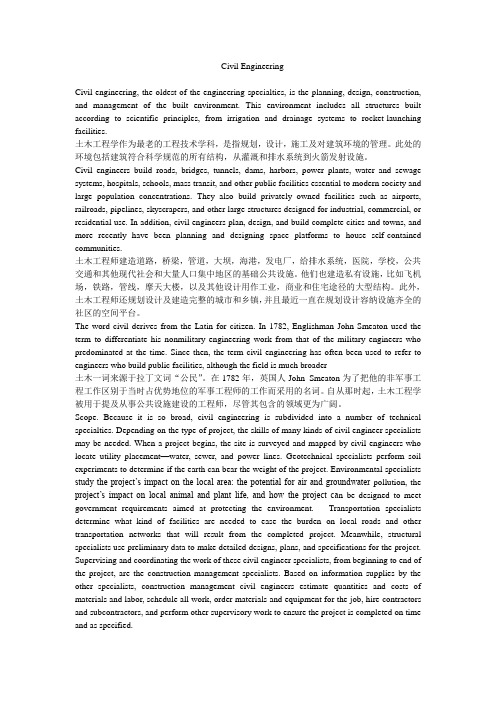
Civil EngineeringCivil engineering, the oldest of the engineering specialties, is the planning, design, construction, and management of the built environment. This environment includes all structures built according to scientific principles, from irrigation and drainage systems to rocket-launching facilities.土木工程学作为最老的工程技术学科,是指规划,设计,施工及对建筑环境的管理。
此处的环境包括建筑符合科学规范的所有结构,从灌溉和排水系统到火箭发射设施。
Civil engineers build roads, bridges, tunnels, dams, harbors, power plants, water and sewage systems, hospitals, schools, mass transit, and other public facilities essential to modern society and large population concentrations. They also build privately owned facilities such as airports, railroads, pipelines, skyscrapers, and other large structures designed for industrial, commercial, or residential use. In addition, civil engineers plan, design, and build complete cities and towns, and more recently have been planning and designing space platforms to house self-contained communities.土木工程师建造道路,桥梁,管道,大坝,海港,发电厂,给排水系统,医院,学校,公共交通和其他现代社会和大量人口集中地区的基础公共设施。
- 1、下载文档前请自行甄别文档内容的完整性,平台不提供额外的编辑、内容补充、找答案等附加服务。
- 2、"仅部分预览"的文档,不可在线预览部分如存在完整性等问题,可反馈申请退款(可完整预览的文档不适用该条件!)。
- 3、如文档侵犯您的权益,请联系客服反馈,我们会尽快为您处理(人工客服工作时间:9:00-18:30)。
土木工程专业英语课文翻译第一课土木工程学土木工程学作为最老的工程技术学科,是指规划,设计,施工及对建筑环境的管理。
此处的环境包括建筑符合科学规范的所有结构,从灌溉和排水系统到火箭发射设施。
土木工程师建造道路,桥梁,管道,大坝,海港,发电厂,给排水系统,医院,学校,公共交通和其他现代社会和大量人口集中地区的基础公共设施。
他们也建造私有设施,比如飞机场,铁路,管线,摩天大楼,以及其他设计用作工业,商业和住宅途径的大型结构。
此外,土木工程师还规划设计及建造完整的城市和乡镇,并且最近一直在规划设计容纳设施齐全的社区的空间平台。
土木一词来源于拉丁文词“公民”。
在1782年,英国人John Smeaton为了把他的非军事工程工作区别于当时占优势地位的军事工程师的工作而采用的名词。
自从那时起,土木工程学被用于提及从事公共设施建设的工程师,尽管其包含的领域更为广阔。
领域。
因为包含范围太广,土木工程学又被细分为大量的技术专业。
不同类型的工程需要多种不同土木工程专业技术。
一个项目开始的时候,土木工程师要对场地进行测绘,定位有用的布置,如地下水水位,下水道,和电力线。
岩土工程专家则进行土力学试验以确定土壤能否承受工程荷载。
环境工程专家研究工程对当地的影响,包括对空气和地下水的可能污染,对当地动植物生活的影响,以及如何让工程设计满足政府针对环境保护的需要。
交通工程专家确定必需的不同种类设施以减轻由整个工程造成的对当地公路和其他交通网络的负担。
同时,结构工程专家利用初步数据对工程作详细规划,设计和说明。
从项目开始到结束,对这些土木工程专家的工作进行监督和调配的则是施工管理专家。
根据其他专家所提供的信息,施工管理专家计算材料和人工的数量和花费,所有工作的进度表,订购工作所需要的材料和设备,雇佣承包商和分包商,还要做些额外的监督工作以确保工程能按时按质完成。
贯穿任何给定项目,土木工程师都需要大量使用计算机。
计算机用于设计工程中使用的多数元件(即计算机辅助设计,或者CAD)并对其进行管理。
计算机成为了现代土木工程师的必备品,因为它使得工程师能有效地掌控所需的大量数据从而确定建造一项工程的最佳方法。
结构工程学。
在这一专业领域,土木工程师规划设计各种类型的结构,包括桥梁,大坝,发电厂,设备支撑,海面上的特殊结构,美国太空计划,发射塔,庞大的天文和无线电望远镜,以及许多其他种类的项目。
结构工程师应用计算机确定一个结构必须承受的力:自重,风荷载和飓风荷载,建筑材料温度变化引起的胀缩,以及地震荷载。
他们也需确定不同种材料如钢筋,混凝土,塑料,石头,沥青,砖,铝或其他建筑材料等的复合作用。
水利工程学。
土木工程师在这一领域主要处理水的物理控制方面的种种问题。
他们的项目用于帮助预防洪水灾害,提供城市用水和灌溉用水,管理控制河流和水流物,维护河滩及其他滨水设施。
此外,他们设计和维护海港,运河与水闸,建造大型水利大坝与小型坝,以及各种类型的围堰,帮助设计海上结构并且确定结构的位置对航行影响。
岩土工程学。
专业于这个领域的土木工程师对支撑结构并影响结构行为的土壤和岩石的特性进行分析。
他们计算建筑和其他结构由于自重压力可能引起的沉降,并采取措施使之减少到最小。
他们也需计算并确定如何加强斜坡和填充物的稳定性以及如何保护结构免受地震和地下水的影响。
环境工程学。
在这一工程学分支中,土木工程师设计,建造并监视系统以提供安全的饮用水,同时预防和控制地表和地下水资源供给的污染。
他们也设计,建造并监视工程以控制甚至消除对土地和空气的污染。
他们建造供水和废水处理厂,设计空气净化器和其他设备以最小化甚至消除由工业加工、焚化及其他产烟生产活动引起的空气污染。
他们也采用建造特殊倾倒地点或使用有毒有害物中和剂的措施来控制有毒有害废弃物。
此外,工程师还对垃圾掩埋进行设计和管理以预防其对周围环境造成污染。
交通工程学。
从事这一专业领域的土木工程师建造可以确保人和货物安全高效运行的设施。
他们专门研究各种类型运输设施的设计和维护,如公路和街道,公共交通系统,铁路和飞机场,港口和海港。
交通工程师应用技术知识及考虑经济,政治和社会因素来设计每一个项目。
他们的工作和城市规划者十分相似,因为交通运输系统的质量直接关系到社区的质量。
渠道工程学。
在土木工程学的这一支链中,土木工程师建造渠道和运送从煤泥浆(混合的煤和水)和半流体废污,到水、石油和多种类型的高度可燃和不可燃的气体中分离出来的液体,气体和固体的相关设备。
工程师决定渠道的设计,项目所处地区必须考虑到的经济性和环境因素,以及所使用材料的类型——钢、混凝土、塑料、或多种材料的复合——的安装技术,测试渠道强度的方法,和控制所运送流体材料保持适当的压力和流速。
当流体中携带危险材料时,安全性因素也需要被考虑。
建筑工程学。
土木工程师在这个领域中从开始到结束监督项目的建筑。
他们,有时被称为项目工程师,应用技术和管理技能,包括建筑工艺,规划,组织,财务,和操作项目建设的知识。
事实上,他们协调工程中每个人的活动:测量员,布置和建造临时道路和斜坡,开挖基础,支模板和浇注混凝土的工人,以及钢筋工人。
这些工程师也向结构的业主提供进度计划报告。
社区和城市规划。
从事土木工程这一方面的工程师可能规划和发展一个城市中的社区,或整个城市。
此规划中所包括的远远不仅仅为工程因素,土地的开发使用和自然资源环境的,社会的和经济的因素也是主要的成分。
这些土木工程师对公共建设工程的规划和私人建筑的发展进行协调。
他们评估所需的设施,包括街道,公路,公共运输系统,机场,港口,给排水和污水处理系统,公共建筑,公园,和娱乐及其他设施以保证社会,经济和环境地协调发展。
摄影测量,测量学和地图绘制。
在这一专业领域的土木工程师精确测量地球表面以获得可靠的信息来定位和设计工程项目。
这一方面包括高工艺学方法,如卫星成相,航拍,和计算机成相。
来自人造卫星的无线电信号,通过激光和音波柱扫描被转换为地图,为隧道钻孔,建造高速公路和大坝,绘制洪水控制和灌溉方案,定位可能影响建筑项目的地下岩石构成,以及许多其他建筑用途提供更精准的测量。
其他的专门项目。
还有两个并不完全在土木工程范围里面但对训练相当重要的附加的专门项目是工程管理和工程教学。
工程管理。
许多土木工程师都选择最终通向管理的职业。
其他则能让他们的事业从管理位置开始。
土木工程管理者结合技术上的知识和一种组织能力来协调劳动力,材料,机械和钱。
这些工程师可能工作在政府——市政、国家、州或联邦;在美国陆军军团作为军队或平民的管理工程师;或在半自治地区,城市主管当局或相似的组织。
他们也可能管理规模为从几个到百个雇员的私营工程公司。
工程教学。
通常选择教学事业的土木工程师教授研究生和本科生技术上的专门项目。
许多从事教学的土木工程师参与会导致建筑材料和施工方法技术革新的基础研究。
多数也担任工程项目或技术领域的顾问,和主要项目的代理。
第二课建筑物与建筑学建筑物的目的是给人类的活动提供一个遮风挡雨的地方。
从穴居时代到现在,人类的第一需要最基本的就是有一个可以遮风避雨之所。
在一个比较一般的感觉中,建筑物的艺术包含人类试图控制环境和直接自然力以满足需要所取得的所有成就。
除建筑物外,这种艺术还包括大坝,运河,隧道,沟渠和桥。
遮风避雨的建筑物的设计和其他功用的土木工程结构的设计的科学基础原理是相同的。
而只是因为现代社会特定的需要,这两个领域才沿着不同的路径发展。
相似的,关注作为遮风避雨的建筑物的主要营造者也不再是一个单独的个体;相反的是由多个专家组成的小组:规划师,建筑师,工程师和建造者。
一个现代建筑物的实现依赖这个小组集体的智慧。
建筑物的结构是建筑物的功能、环境及各种社会经济因素共同作用的产物。
公寓,办公大楼和学校的不同在于它们实现的功能不同。
公寓的每一个可居住空间如起居室和卧室必须有来自窗户的自然光,而浴室和厨房可以采用人造光源因而可以安排在建筑物内部。
这种必要的设置对公寓的进深必然有限制。
另一方面,对办公大楼而言,人造光源更能达到均匀照明的要求,因此,对自然光的需求不再有建筑物进深的限制。
环境可能影响到建筑物的形状和外观。
城市里的学校通过使用空白的围墙完全的封闭于城市之外,而乡村的学校可能发展成为景观的一个主要部分,即使两者实现同样的功能。
最后,建筑物的结构被各种社会经济因素影响,包括地价,租赁,工程预算,分区限制。
城市的高地价造成高层建筑物,而乡村的低地价造成低的建筑物。
富人的住房建筑计划不同于廉价的住房建筑计划。
有威望的办公大楼的预算将大大地超过其他的办公大楼。
建筑物的大小和外形可能受到分区的限制。
在所有这些例子中,有着相似功能的建筑物常常采用不同的结构。
建筑学是建筑物的艺术。
事实上所有的建筑学都是关于为了人类的使用而围住的空间。
在任何特殊的建筑物中所覆盖的精确活动——广泛到从工厂的一条装配线到一个家庭的起居室——应该规定几个内部区域的大小和形状。
这些空间也必须被安排在彼此合乎一定逻辑的关系中。
此外,在建筑物中的人类活动——建筑学中的说法是“流通”——需要大厅,楼梯和电梯,它们的尺寸受到预期荷载的支配。
建筑物的结构平面图,总是建筑师的第一考虑,是深入实现建筑物意图的空间组织中的这些不同目的的决定。
好的平面组织可以指引访客到达他们的在建筑物中的目的地并且使他们留下印象。
他们也许是下意识地被大厦很显然的各个单元的关联所指引。
相反地,不好的平面组织将带来不便,浪费和视觉混乱。
此外, 一个结构需要很好地被建造。
它应该有结构需要的和被选材料允许的耐久性。
建筑学的未经加工的材料,如石,砖,木,钢或玻璃,部分决定了建筑物的结构并对建筑物进行表达。
石能抵抗压缩,尽管一起压挤的力几乎是不能确定的。
在一个实验室里压碎石是可能,但是对于实际应用,它的抗压强度则是无限的。
另一方面,石在抵抗各向拉力方面是很弱的。
任何空间跨度的梁在支承之间容易向下弯曲,梁的下半区承受拉力。
由于石承受拉力的能力很弱,这种材料的梁相对地比较短, 并且支撑间距比较小。
此外,石柱必须坚固,其高宽比极少超过10。
在石类建筑中,门,窗及柱之间的空间几乎都被迫高大于宽,这源于石的垂直矩形美学。
石在西方世界建筑学中占有如此之高的统治地位,以致,即使在木结构建筑时期其适当的造型一直被妥善保护着,像在美国的乔治王时代。
然后,石借助它本身的构造类型,成为支撑楼板和屋顶的墙,成为承重结构中的密排柱,成为主要承受压力的拱形结构。
木是一种纤维材料,相比其抵抗压力的能力而言,它更易于抵抗拉力。
木制梁可能相对比石制梁长,并且木制柱较细且可以广泛地作一定间隔的排列。
由于木的自然性质常形成宽大于高的水平矩形,这在日本建筑学中常被见到。
钢的抗拉强度也等于或大于其抗压强度。
已经观察过钢结构建筑物建筑过程的任何人一定曾注意到由细的广泛地作一定间距排列的柱及每个楼板的长梁所组成的水平格状矩形。
